RYAN GOSLING

Dream projects, timeless style – and the chase for Carrera





Dream projects, timeless style – and the chase for Carrera




Conceived in 2022, Duveen+Vollard is new to the scene but is backed by a team that has decades of experience in both the arts and logistics industries.

Born out of our own frustrations over astronomical prices and a process that seemed ever-complicated, we developed D+V to simplify logistics within the art market and increase affordability whilst retaining the highest standard of care.

Duveen+Vollard’s comprehensive logistical support and storage service is tailored for artists, galleries, art fairs, auction houses, collectors, museums and corporate clients alike.

We offer our clients peace-of-mind with a reliable service and unparalleled attention to detail. Our artwork storage facility, conveniently based just outside of London, offers a secure, high-quality space. Whether you require assistance shipping one piece or organising a large scale exhibitions, we have you covered.

 MODERN.FORWARD-THINKING.REACTIVE
MODERN.FORWARD-THINKING.REACTIVE


PROTECTING EVERYTHING AND EVERYONE YOU HOLD DEAR
INVESTIGATIONS & SURVEILLANCE


TECHNICAL SURVEILLANCE COUNTER MEASURES (TSCM)

FULL SECURITY AUDITS
PENETRATION TESTING

Valkyrie is a specialist security organisation drawing on over 100 years of combined experience in Britain’s most elite military and intelligence units. We protect you, your families, homes and businesses by delivering high-level cyber and physical security solutions, tailored to your individual needs. Whether you are looking for a discreet and comprehensive way to safeguard your family’s interests, or you are a UK or international business looking to mitigate security risks, we are committed to building long-term, trusted relationships that you can rely on.























hat is experiential luxury? As a term, it’s a trend that has been growing for several years, even before the Covid-19 pandemic forced a seismic shift in our interactions with consumer brands, and inextricably linked with the idea of luxury becoming less formal and more individual. In the world of travel, it’s no longer enough simply to offer incredible service. Individualised wellness and cultural programmes, to curate an experience like no other, make a world of difference. And, when it comes to luxury items, we often find that the storytelling of a product is just as important as exceptional craftsmanship.
Take, for example, the launch of the ultra-rare and ultra-indulgent The Singleton 40-Year-Old. It has been released as the third and final rare whisky in the brand’s Epicurean Odyssey series and limited to just 1,716 bottles globally, so one would think the craftmanship alone of this exceptional scotch, by renowned master blender Maureen Robinson, would be left to speak for itself – the taste certainly does. Instead, The Singleton partnered with leading expert in neuroaesthetic science – Katherine Templar Lewis – to curate a sensory experience that
Wallows us to further enhance and enrich the flavour by engaging all of our senses (find out more on page 54).

Similarly, when I sat down with actor Ryan Gosling and TAG Heuer CEO Frédéric Arnault for this issue’s cover story (28), both were excited to emphasise the creative approach that influenced every part of their latest collaboration – a collaboration that started as a commercial campaign to celebrate 60 years of the TAG Heuer Carrera timepiece, and soon evolved into the fiveminute action-comedy film The Chase for Carrera, and which as fun and thrilling as any Hollywood blockbuster.
As we seek more meaningful – and more interesting – experiences with the brands we engage with, it’s encouraging to see the luxury world rise to the occasion, meeting us with verve, creativity and passion, sharing their stories in endlessly interesting and thought-provoking ways. Whether that’s through the technological innovations that are bringing us evercloser to autonomous vehicles (76) to the chefs bringing their own personal tastes and cuisines to London’s extraordinary and ceaselessly evolving gastronomic landscape (46), these are the luxury experiences well worth savouring – and I hope this issue gives you every bit as much pleasure.
Michelle Johnson Editor

AS WE SEEK MORE MEANINGFUL EXPERIENCES, IT’S ENCOURAGING TO SEE THE LUXURY WORLD RISE TO THE OCCASION
Rikesh Chauhan
Get ready to turn heads with Tempus style columnist Rikesh’s top millinery masterpieces for the summer season (36)

Editor-in-chief
Michelle Johnson michelle@tempusmagazine.co.uk
Creative Director
Ross Forbes ross@tempusmagazine.co.uk
Digital Content Editor
Tessa Crowley tessa@tempusmagazine.co.uk
Wealth Editor
Lysanne Currie

Motoring Editor

Rory FH Smith
Lauren Jade Hill
Journalist Lauren speaks to some of the most exciting chefs in the world as they tuck into London’s dining scene (46)

Chief Sub-Editor
Dominique Dinse
COMMERCIAL
Sales & Partnership Enquiries info@tempusmagazine.co.uk +44 (0) 203 519 1005
Lauren Jarvis
Travel expert Lauren heads to Botswana for our ultimate guide to finding the country’s greatest safari experiences (68)
VANTAGE MEDIA Chairman
Floyd Woodrow
Managing Director
Peter Malmstrom
COVER IMAGE
Rory FH Smith
Our motoring editor heads on a nostalgic tour of Tuscany (24) before getting futuristic to explore the rise of autonomous vehicles (76)
Ryan Gosling wears a TAG Heuer Carrera Chronograph. © Photo courtesy of TAG Heuer Article on page: 28
tempusmagazine.co.uk info@tempusmagazine.co.uk +44 (0) 203 519 1005
10 The luxe list Our essential guide to the finest gifts and most exciting new launches of the season
14 The time is now Discover the latest trends in haute horology as we head to Watches & Wonders
20 Message in a bottle As the Golden Vine Awards heads to Paris, we speak to founder Lewis Chester about the Oscars of fine wine
24 La dolce vita A road trip through Tuscany reveals the romance of the Italian road
28 Chasing the future Ryan Gosling keeps time with TAG Heuer as he celebrates 60 years of the Carrera
36 Turning heads Get ready for the summer seasons with our stylish pick of hats and millinery
40 London calling As the FIA Formula E returns to London, we chat to some of this year’s key figures

46 Appetite for more Meet the world’s top chefs elevating London’s world-leading restaurant scene


54 A matter of taste Neuroaesthetic scientist Katherine Templar Lewis partners with The Singleton for a sensory experience like no other
58 Escape to happiness Go wild – and tech-free – in Finland’s dramatic and restorative landscape
62 Skin deep When it comes to beauty buzzwords, we’re more clued up than ever – but are we ready to get scientific?
66 Positive skinfluence Science-led beauty products for the skintellectual consumer
68 Beyond the delta We head to Botswana for the nation’s most extraordinary safari experiences
74 Down to earth Are ultra-high net worth individuals giving up their private jets?
76 Backseat driver From high-tech cars to self-steering yachts, the autonomous era is about set off
82 Rise of the business rockstar When it comes to reputation, these strategies could supercharge your brand and business
86 City living The chart-topping cities leading the Global Wealth & Lifestyle Index
88 Material world Artist Joana Vasconcelos on building monuments to generations of women – and her most ambitious installation yet
92 Scents of space Everything you need to ‘scent train’ your home – the indulgent new trend in interior design
96 Forever young Wellness in body and mind is a truly prized asset and, for these UHNWs, age is nothing but a number
100 A woman’s work Celebrating 50 years of women on the London Stock Exchange
103 RE:VIEW Hollywood star Ryan Reynolds shares his favourite summer cocktails, plus our pick of must-visit restaurants, exhibitions and events
108 Save the date The finest events of the season
112 Out of office ensembles Get ready to vacation in style with Rikesh Chauhan’s ultimate holiday staples
ISSUE 83

Our essential guide to the most exciting new launches and finest seasonal gifts

Celebrating its 10th anniversary, fine jewellery brand Loquet London has launched a playful new collection, Ipseity. Loquet founder Sheherazade Goldsmith describes the milestone collection, including charms and heirlooms, as the embodiment of identity, selfhood and individuality. The collection includes colourful, personalised locket pendants including the agate and sapphire Sunrise Locket (right), a pink and a yellow sapphire locket – symbolising new beginnings – and the uplifting Tessellated Sapphire Locket.

loquetlondon.com
2 4 1
of the original 1963 Heuer Carrera, this chronograph is a fitting tribute to mark the collection’s 60th anniversary. The two new collection pieces, both with 42mm stainless steel cases and powered by the in-house automatic chronograph Heuer 02 movement, offer style in the dial – one in the brand’s signature blue (left) and one in “brooding black” – with vivid orange detailing and finished with calfskin straps. The striking timepieces reference Jack Heuer’s original designs with their high legibility, simple round casing and ergonomic chronograph pump pushers at 2 and 4 o’clock – the ultimate in dynamic style and racing spirit. Find out more on page 28
tagheuer.com
3
Calling all melophiles: if you’re a vinyllover on the go, this nostalgic piece of kit is the perfect summer accessory. This retro portable record player was first relaunched last year as part of the brand’s 60th anniversary celebrations, but sold out worldwide in a matter of days. Now, Audio-Technica has released new retro colourways in black, white and yellow (left). Not only is the Sound Burger compact for easy travel, it includes a belt-drive system playing 331/3 and 45 RPM records, a 12 hour battery, Bluetooth wireless audio and USB-C port for easy charging. This is love at first listen.

audio-technica.com

The fifth release in premium whisky Royal Salute’s Polo Collection is bringing scotch-lovers a taste of India with its new 21 Year Old Jodhpur Polo Edition (right). Master Blender Sandy Hyslop’s latest creation transports us to Rajasthan’s Blue City and the sport of kings alike, with a blend of bespoke malts fully finished in virgin oak casks. The result is reminiscent of the sweetness of a mango chutney with a surprisingly spicy finish. On the nose, fruity aromas of mango, pomegranate and coconut are complemented by vanilla and ginger jam, bringing out the rich and spicy flavour on the palate. The taste combines notes of dark chocolate, caramel and honey, as well as cinnamon, cloves and ginger for a flavoursome kick, before a long and spicy finish. A fitting addition to this kingly collection. »
royalsalute.com
5 6
Ahead of the Praga Bohemia’s debut later this summer, the all-new high-concept hypercar (left) is enjoying road testing at a variety of events and world-famous tracks – including the Slovakiaring circuit in the brand’s home-country of Slovakia. With just 89 cars to be handmade over a four-year period, the hypercar will be priced at €1.36m when it goes on sale in August. Praga’s development will see the Bohemia target 982kg wet weight without fuel, be fully road-legal and aims to match GT3 race car lap times on its semi-slick Pirelli tyres, while still being comfortable and practical enough for overnight road trips. Start your engines…

pragaglobal.com
Art and design gallery Studiotwentyseven combines contemporary art, enduring craftmanship and unique statement pieces with its collection of furniture and home accessories. With new gallery spaces launching in Miami and London this year, and viewings already available on appointment, collectors can admire – and take home – exclusive works by the likes of French-Israeli architect and designer Emmanuelle Simon (whose Raku Yaki Bar is pictured, right), French designer Francesco Balzano and interior and product designer Louise Liljencrantz. After all, home is where the art is...
studiotwentyseven.com

7
The Sparrow Cigar Room
Mayfair restaurant Sparrow Italia has launched a new Cigar Room for aficionados of global cigars (left). The 25-person venue has a menu curated by cigar sommelier and master of Havana cigars Syafiera Rosidi, and includes cigars from Cuba, the Dominican Republic, Honduras, Costa Rica, Mexico, and select areas from South America. Each cigar in the collection is handmade with full-leaf tobacco, chosen for its taste, draw, and overall quality and consistency – and features legendary brands such as Cohiba, Trinidad, Romeo y Julieta, Montecristo, Hoyo De Monterrey, Partagas and Davidoff. Enhance your evening with a glass of whisky, cognac or tequila for an indulgent tasting experience.
sparrowitalia.com

The travel collaboration for the summer is here in the form of W Maldives new resort wear collection with Hong Kong brand Mazu (left). Designed as sustainable resort wear for the conscious traveller, this collection of underwater swimwear, surfing rash guard and more embodies the beauty of the Indian Ocean archipelago. Each piece is made from recycled nylon from salvaged plastic bottles, and designed to protect the skin from harmful UV rays while swimming, snorkelling and surfing in the ocean – not to mention adorned with an exclusive print inspired by stunning reefs that surround W Maldive’s Fesdu Island.

marriott.com
Recent figures from Business Insights suggest the UK is becoming a nation of sakelovers and the UK’s preferred premium brand Akashi-Tai is celebrating with a portfolio of delectable Japanese beverages. Familyrun since 1856, Akashi-Tai is handmade in small batches by fourth-generation toji (sake master) Kimio Yonezawa. If you’re new to the world of sake, go for the classic Tokubetsu Honjozo over dinner. For a heightened experience, the brewery’s ‘grand cru’ Junmai Daiginjo Genshu is unmissable, while its Sparkling Junmai Ginjo (right) is bottlefermented in the same style as champagne to create a gently carbonated rice wine. Kanpai.

akashisakebrewery.com
Is there anything better than a rooftop lounge on London’s sunniest days? Four Seasons Hotel London at Ten Trinity Square is raising the bar on this summer indulgence with a pop-up rooftop lounge that combines great food and cocktails with stunning views of London landmarks – including Tower Bridge, The Shard, the Tower of London and River Thames. The hotel’s Crown Residence and terrace has been transformed by floral masters Wild at Heart, while Bloom’s menu includes botanical-themed cocktails to locally-sourced cheese, charcuterie and sweets. Open until 31 August, this is the perfect vantage point to see London in bloom.
fourseasons.com

Each year, the best and brightest minds in the watch industry gather in Geneva to discover the latest releases and innovations in haute horology. And 2023 Watches & Wonders – organised by the Fondation de la Haute Horlogerie from 27 March-2 April – was bolder than ever, with keynote conference from the likes of TAG Heuer’s Frédéric Arnault, Chanel’s Frédéric Grangié, and Chopard’s Caroline Scheufele.
But aside from the giants of the watch world – as well as celebrities such as Chopard ambassador Julia Roberts – making their appearance, the event was also the home of several incredible launches and novelties making their debut.

Major themes included mechanical innovations from the like of Hublot, Roger Dubuis and Ulysse Nardin, and high jewellery complications from Van Cleef & Arpels and Piaget. Interestingly, alongside the mechanical excellence, design aesthetic was also under the spotlight – seen not only in the highly elevated square and rectangular timepieces making a major comeback, thanks to the likes of Jaeger-LeCoultre (Reverso Tribute Duoface Tourbillon, right) and Cartier, but also in the form of exceptional, brightly coloured dials. Where previous years saw racing green hit the horological runway, this year’s blue, teal, salmon and hot pink dials were a cut above the rest. Read on to discover our best in show… »
watchesandwonders.com

HUBLOT MP-13
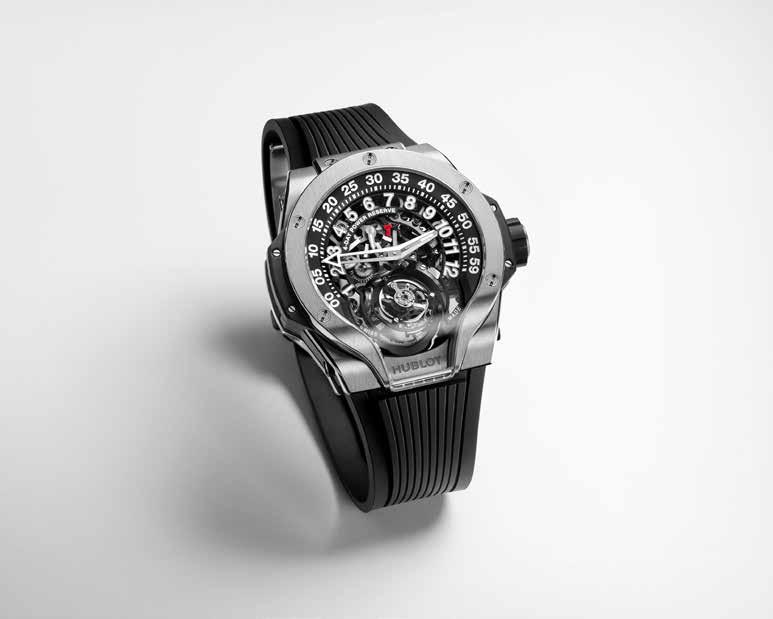
This year’s event saw many stand-out timepieces from Hublot, not least the Square Bang Unico Jewellery (with 138 pavé white diamonds totalling 3.3 carats) and featherlight-weight Big Bang Integrated Tourbillon Full Carbon (weighing just 26g). But the real mechanical stand-out was the new MP-13 (right). A 44mm brushed titanium case houses two complications –Hublot’s skeletonised and suspended double-axis tourbillon, and a unique bi-retrograde movement. On the dial, the minute hand glides smoothly, while the hour hand skips between numbers for high-legibility, with a visually pleasing jumping hour hand that skips from 12 to 1.
hublot.com


ULYSSE NARDIN FREAK ONE
Ulysse Nardin has always pushed the boundaries, and this year’s launch of Freak One (left) continues the trend in triumph. Powered by the brand’s automatic calibre UN240 Manufacture, the 44mm case is black DLCcoated titanium with a satin finish and rose-gold 5N bezel, finished with a rubber strap made of 30% recycled material. So far, so normal. Inside the case, though, owners will find no dial, hands or crown – instead, the flying carousel rotates around its own axis, and it is the complication itself that provides the time.
ulysse-nardin.com
The hyper horology experts have stepped up their game yet again – this time by reinventing the tourbillon itself. Positioned at 9 o’clock, the Conical Monovortex Tourbillon (right) has a 360° trajectory to protect the precision of the watch at any position. Further, the brand has developed the Turborotor Cylindrical Oscillating Weight, which sits at 12 o’clock and is positioned vertically to harness gravity like a spinning barrel to keep the winding of the watch more efficient. With a split-seconds chronograph and playful rotating minute counter, and case made of hyper-tech Mineral Composite Fibre (MCF) – presented in a rare shade of red – this is a futuristic masterpiece.
rogerdubuis.com
IWC SCHAFFHAUSEN INGENIEUR AUTOMATIC 40
A remodelling of designer Gérald Genta’s iconic Ingenieur SL from the 1970s, the new Ingenieur Automatic 40 is an effortlessly stylish and elegantly ergonomic timepiece that encompasses IWC Shaffhausen’s approach to clean watchmaking. The collection comprises three references in stainless steel and one in titanium, all powered by IWC’s 32111 calibre with a power reserve of 120 hours. The case, bezel, and bracelet all boast a high polished and satin-finish, while the upper parts of the bracelet contain closed links without pins for added comfort. The dial comes in classic black or silver-plated, as well as the real stand-out – the new aqua dial with rhodium-plated hands and appliques (right). A true statement.
iwc.com
FREDERIQUE CONSTANT HIGHLIFE
LADIES AUTOMATIC SPARKLING

Celebrating 25 years of watchmaking, Frederique Constant has combined two key dial trends with its Highlife Ladies Automatic Sparkling (left) – natural materials and bright colours. The 34mm stainless-steel case provides a chic frame from which the bright sky-blue dial can make its statement – with glints of stardust, a bezel gleaming with diamonds and hours marked with diamonds. An integrated steel strap makes it perfect for formal settings, while a second interchangeable cloud-white rubber strap allows for more casual style.
frederiqueconstant.com
ROLEX OYSTER PERPETUAL COSMOGRAPH DAYTONA

Presented in a 950 platinum case with cool iceblue dial, Rolex’s Oyster Perpetual Cosmograph (left) is a wickedly stylish reference in the Daytona collection. Snailed counters, 18ct gold applique hour markers and hands with a Chromalight display make for clear legibility, while a central sweeping seconds hand and two time counters on the dial display ensure drivers can accurately map out their track times and tactics. Meanwhile, the bezel features a tachymetric scale for measuring average speeds of up to 400mph.
rolex.com


While Tudor’s exceptional Black Bay 54 was the talk of Geneva, the brand was quietly showcasing a fleet of effortlessly stylish novelties in the form of the Tudor Royal. In four sizes – 28mm, 34mm, 38mm and 41mm – and two dial colours – radialbrushed salmon (right) and chocolate brown dials – this is a chic and super versatile timepiece designed to fit the style of any wearer. The watch includes an integrated metal bracelet, notched or diamond-set bezel and automatic movement. » tudorwatch.com
VAN CLEEF & ARPELS LUDO SECRET WATCH


The Ludo Secret is a contemporary interpretation of Van Cleef & Arpels’ first Ludo bracelets, created in 1934. The perfect blend of high jewellery and haute watchmaking, it has taken decades for the artisans to recreate the smooth opening mechanism by which the hidden watch dial is revealed to the wearer. Presented in yellow gold, the Ludo Secret Watch is available with stunning diamonds or pink sapphires – but the most dazzling reference in the collection is surely this Ludo bracelet with its dial hidden behind a motif of Mystery Set emeralds, highlighted by white mother-of-pearl and diamonds (right).
vancleefarpels.com
PIAGET LIMELIGHT AURA

Returning to its roots of high glamour, Piaget presented an ‘extraleganza’ of timepieces at this year’s Watches & Wonders. Chief among them was its Limelight Aura High Jewellery watch (right) – a show-stopping 18ct white-gold piece set with diamonds and sapphires blending perfectly together. Piaget also upped the glamour with a modern take on its precious 1969 sautoirs. This year, two handcrafted Swinging Sautoirs combine twisted gold with delicate watchmaking – the most eye-catching is a tassel-style sautoir set with a 25.38ct oval cabochon Zambian emerald to match its oval-shaped dial.

piaget.com

CHOPARD IMPERIALE
Limited to just 25 pieces, all in ethical 18ct rose gold, this high jewellery timepiece (right) is based on the beauty of the sacred lotus. A gold lotus flower on the dial acts as a day-night disc with a 24hour rotation, gradually changes face in passing from darkness to light – thanks to a dial of bluegradient mother-of-pearl centre and powdered gold stars. The petals themselves are arranged in a polished rose gold lacework, delicately resting on other curved petals in engraved and satin-brushed gold, and edged with diamonds.
chopard.com
ALONGSIDE MECHANICAL EXCELLENCE, THIS YEAR DESIGN AESTHETIC WAS ALSO UNDER THE SPOTLIGHT
JAEGER-LECOULTRE REVERSO TRIBUTE CHRONOGRAPH

Celebrating the Golden Ratio of geometry, Jaeger-LeCoultre’s 2023 Reverso collection is full of unique design and pleasing combinations of complications. The Reverso Tribute Duoface Tourbillon (left) presents a flying tourbillon set within an ultra-thin Duoface movement, displaying a second time zone on the reverse dial, while four new Tribute Small Seconds models introduce new colour variations to the dials. One stand-out model is the Reverso Tribute Chronograph, featuring a new Calibre 860 that reveals the chronograph mechanism on the reverse side as well as displaying the time indication on both front and reverse. The epitome of multi-faceted.
jaeger-lecoultre.com
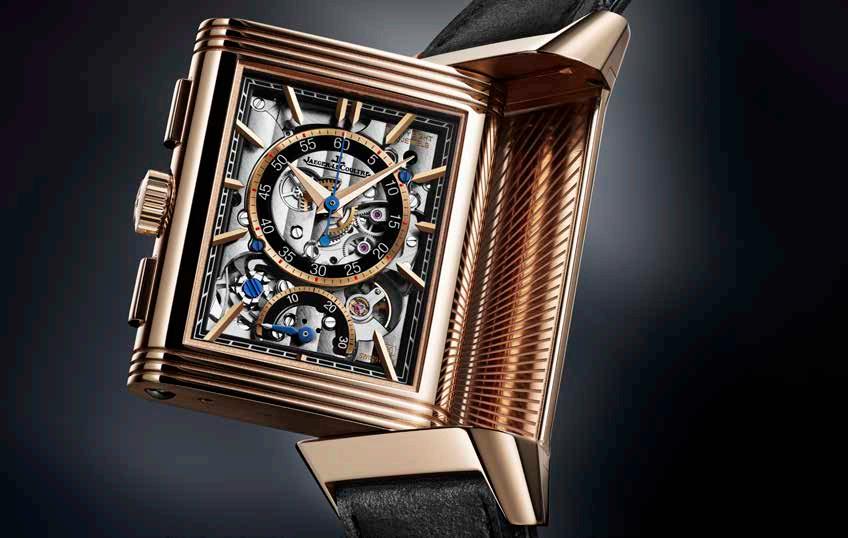
BELL & ROSS BR 05 GREEN GOLD
Making their Watches & Wonders debut, Bell & Ross proved it’s hip to be square with their collection of 2023 novelties – including the avant-garde BR 01 Cyber Skull Bronze and the BR 05 Skeleton Golden. Perhaps the most sophisticated is the new BR 05 Green Gold (left), combining a gold case and bracelet with a bottle-green sunburst effect dial. Depending on the light and reflection, the dial varies between a fluorescent shade to darkest green. All novelties are encased in Bell & Ross’s signature square case and round dial, inspired by aeronautical instrumentation found in vintage cockpits.

bellross.com
CARTIER TANK AMÉRICAINE & SANTOSDUMONT SKELETON

Is there anything more stylish than a Cartier Tank? Proving that classic elegance never fades, the latest Tank Américaine collection (below) reenforces the original 1989 design in a choice of all-gold and steel with a leather strap, rose gold and diamonds with a leather strap or diamond-paved white and rose gold with a metal bracelet. Elsewhere in Cartier’s collection, a new skeletonised Santos-Dumont (below left) features a rose-gold or steel case, visible screws, a beaded crown and blue cabochon, as well as a miniaturised functional oscillating weight in the shape of the Demoiselle – the trailblazing plane designed by pilot Alberto Santos-Dumont in 1907.
cartier.com

As the Golden Vine Awards heads to Paris this October, founder Lewis Chester tells us about the lasting friendship that inspired him to create the Oscars of fine wine
Words: Michelle Johnson
“All the best ideas happen over a long lunch with a great wine,” says Lewis Chester (pictured left). A former investment manager and oenophile, Lewis’ dream of investing in the world’s most interesting and exceptional wines got serious when he first met renowned sommelier and co-founder of renowned Hotel du Vin chain, Gérard Basset OBE. Gérard – who, at the time of his death in 2019, was the only person in the world to hold the combined titles of Master of Wine, Master Sommelier and World’s Best Sommelier – encouraged Lewis to pursue his passion for fine wine.
“Gérard was the first to encourage me to study wine education. He thought that if I wanted to become one of the world’s best fine wine collectors, I really needed to study wine,” he says.
Lewis, already an Oxford University and Harvard Business School graduate, took his friend’s advice seriously; he was soon awarded the Champagne Academy Scholarship by the Wine & Spirits Educational Trust (WSET) and prestigious WSET Hardy’s Vintage Scholarship 2017, and now holds the WSET Wine Diploma. In May 2018, Lewis was made a Chevalier du Tastevin de Bourgogne.
With such shared expertise and passion, the pair founded Liquid Icons, a fine wine research and content production company that allowed them to explore the very best and most diverse produce from the worlds of wine, spirits and hospitality. After Gérard’s
death in 2019, Lewis partnered with the sommelier’s widow Nina and son Romané to establish the Gérard Basset Foundation, with the aim of addressing inclusivity and diversity within the industry through education, training and mentorship.
“The world of wine needs to embrace a wider and more diverse group of people to stay relevant,” Lewis explains. “It’s something that Gérard was passionate about, and why we also launched the Gérard Basset Global Fine Wine Report to see the micro and macro trends that are shaping the industry.”
Around the same time – over a long lunch with a great wine – Lewis came up with the idea of a fine wine gala that was modern, fast-paced, celebratory and, crucially, he says, “not boring”. The first Golden Vines Awards gala was held in 2021, hosted at Annabel’s private members’ club on London’s Berkeley Square, and with entertainment by pop superstar Kylie Minogue. Buoyed by his success, the following year Lewis took the show on the road, creating a three-day event in Florence, Italy.
This October, The Golden Vines Awards 2023 will take to the salons of Paris, and the Champagne region, with three days of festivities that include masterclasses from the world’s greatest producers to tasting tours of champagne, food by Alain Ducasse and entertainment all culminating in a sensational gala at the Palais Garnier. »
Lewis, what can we expect from this year’s Golden Vines Awards?
The event starts in Paris, Friday 13 October, with a series of masterclasses from some of the greatest winemakers on the planet: Domaine LeFlaive, Domaine Hubert Lamy, Domaine ArnouxLachaux and Domaine Jean-Yves Bizot (four absolute stars of Burgundy). We have champagne masterclasses from Dom Pérignon and Champagne Salon, and classes from top wineries in Italy. That evening, we’ll be hosting a party at the Musée des Arts Forains [Paris’s fairground museum], which is a super cool venue, and then on Saturday we’ll host a series of lunches with extraordinary chefs in some of Paris’s top venues. Saturday evening is a black-tie awards gala, hosted at the Palais Garnier – the Paris Opera House. We’ll have food by Alain Ducasse, extremely special rare wines donated by unbelievable winemakers, auction prizes donated by our sponsors, and surprise entertainment. All of the wines we’re serving are created by our nominees, and the list includes some of the most expensive magnums in the world. Sunday will finish the weekend with a series of events in the Champagne region, with the likes of Charles Heidsieck and Dom Pérignon.
How has the event grown since the first gala at Annabel’s?

That first ceremony was incredible. We had the most amazing wines and brilliant sponsors, Kylie Minogue performing, it was wonderful. After the first event, my mother called me and said: ‘I’m very proud of you… but maybe you should quit now while you’re ahead.’ People who know me will probably tell you they were wise words, but instead I took the complexity of the event to a new level by choosing a different host city every year. Our second year, in Florence, wasn’t just one night, but a series of events over a long weekend, combining wine masterclasses, wonderful lunch events, the charity element and putting the spotlight on our winners. Each year we take the best elements from the events and add even more to the programme, so it will be extraordinary.
What inspired you to launch the Golden Vines Awards?
The idea was developed over a liquid lunch with my business partner Sasha Lushnikov,
who had been introduced to me by a school friend as a super-smart young entrepreneur and Clément Robert, master sommelier and head of beverages at the Birley Clubs, including Anabel’s. We were drinking a vertical of Riesling Clos from Trimbach – one of my favourite white wines – and I started pitching this idea of a fine wine event that wasn’t boring, was more modern, combining incredible food, wonderful wine, world class entertainment, cool people and an amazing location. Clément loved it, and introduced us to businessman Richard Caring, who was the first to suggest tying in a charitable element. I phoned Gérard’s widow, Nina, and explain our crazy idea to put on the Oscars of fine wine, and suggested we use it as a platform to raise money in Gérard’s name.

You established the Gérard Basset Foundation in 2019. Please tell us more?
It was set up to honour the legacy and memory of Gérard and the work he did. The fine wine world, for many cultural and historical reasons, is one of the least diverse and inclusive, so we decided we should use our funding for wine education programmes to enhance diversity and inclusion in the industry. We wanted the foundation to have a lasting and profound impact on the wine industry that Gérard would have been proud to put his name to.
Could you tell us about the scholarship opportunities that you offer?
We provide funding for numerous groups and community partners worldwide and have 35 alumni and scholarship-winners so far, since 2020. As well as supporting education and start-ups, we work with groups and institutions to find the people who really need support. For example, as well as working with institutions in wine regions like California and Bordeaux, we also work with organisations like Okanagan College in Canada to support indigenous students; the Hue Society, which supports black, brown and indigenous representation in the wine industry; and The Pinotage Youth Development Academy helping disadvantaged people in South Africa enter the wine industry. We also support disability programmes such as Wine on Wheels in New York. This year we will have new funding programs in Brazil, India,
Angola and Israel, as well as programmes around victims of conflicts. So, we’re really expanding internationally – wherever there’s a problem in the world of wine, spirits and hospitality, we want to be there to help.
Where did your interest in wine begin?
I started building an interest in wine at Oxford University and then, when I went to Harvard Business School, I started a wine, whisky and cigar club called The Churchill Club. We had the distinct pleasure of being the first American club to get permission to go to Cuba – we were funded by the Ministry of Tobacco and had to go in via Montreal, Canada. When I came back to the UK, I was really into Scotch whisky, but my best friend was a big wine collector and he lured me back into wine. I started buying mainly Bordeaux and then, as I always say, all roads lead to Burgundy.
You’re passionate about the stories behind the wines and vineyards that you invest in. What is it that you look for?
Often, great vineyards are steeped in history and stories of triumph over disaster –especially as an agricultural product that’s subject to a single harvest. When you have to fight the weather, natural disasters, as well as historical events, you find a lot of interesting stories. For example, the 2017 Barolo Ester Canale Rosso, by Giovanni Rosso, is a beautiful wine by one of the world’s greatest winemakers, but it’s all the more special when you consider that the vines were planted by the owners – a Jewish family – in 1946, after surviving the Second World War.
Another winemaker I collect is Lorenzo Accomasso, who at 82-years-old is still making incredible Barolos that he sells from his cellar door. If you want to buy his wine, you have to physically go to his home in Piedmont and knock on the door. Lorenzo also has a barter deal with his favourite restaurant in Piedmont, where he swaps lamb for wine. These are the kinds of stories I’m attracted to – they’re all stories about artisans and, often, about real characters within the industry, who deserve to be celebrated.
liquidicons.com/work/golden-vines-awards
The golden touch: Entertainment at the 2022 Golden Vine Awards (right, ©GettyImages); The Gérard Basset Foundation was founded in honour of the renowned Master Sommelier (left, ©LiquidIcons).
Previous: Lewis Chester (©Murray Ballard)

With luscious andscapes, legendary artworks and local delicacies, there’s a lot to love about Tuscany. For centuries this corner of Italy has attracted travellers; from bright young things embarking on the Grand Tour and 18th-century romantics, to today’s tourists looking to bask in the region’s unparalleled beauty. With hotspots like Florence and Siena congested during the peak seasons, it’s well worth hitting the road behind the wheel of something suitably stylish (and, ideally, Italian) and heading to the less populated areas to unearth some of Tuscany’s best-kept secrets.
Choosing to do just that, I first lay eyes on my road trip steed – a vintage Alfa Romeo Spider –moments after landing at San Francesco d’Assisi Airport on the outskirts of Perugia. First released







in 1966, this four-wheeled representation of la dolce vita is the definitive Italian sportscar, with its Rosso Corsa paintwork, beguiling bug eyes and streamlined silhouette. Testament to its design, the original Alfa Romeo Spider remained in production until 1994, with only slight tweaks to the styling and engineering that underpinned it. With keys in hand and canvas roof dropped, I head for the hills due north of the airport. After a blast up the E45 motorway, I make my way to the hills above Arezzo, aiming for a particularly picturesque converted farmhouse that will serve as my base. Once off the main motorway, I am quickly absorbed into the dense forest that occasionally gives way to vistas over long lakes and impossibly beautiful hilltop towns. It’s hard to resist pulling over on every sweeping bend to
soak up the serenity and sheer beauty of a rolling landscape peppered with vines, olive trees and hilltop villages.
Closing in on my base, high on the hilltop, the Alfa crunches its way up the steep gravel driveway to La Palazza nel Cielo, a cosy converted 200-year-old farmhouse. Once through the door, its gloriously big shuttered windows looking out onto farmland, hills and the villa’s heated infinity pool, letting light in from every angle. Built on the hillside, La Palazza nel Cielo is typical Tuscan farmhouse consisting of layers and different levels. Complete with pool, a vast games roomand-gym and six bedrooms, the well-appointed and beautifully furnished villa comfortably sleeps 14. There are even log burning stoves for the cooler months. »


Settled in and unpacked, I head out on my first adventure in the Alfa, taking the twisting road down to Sansepolcro, the largest town in the Valtiberina. With a strong link to the tradition of lacemaking, this charming walled town is also an architectural and art hot spot, boasting a cathedral as well as galleries and museums housing the paintings of Perugino, Piero della Francesca to name but a few famous local painters. There’s plenty of parking outside of the town’s walls and only a short walk to the main square – sit outside in one of the many cafes and sip an espresso while locals dart around on bikes and scooters as the church bells chime on the hour. Sansepolcro is home to the Palio della Balestra – the town’s crossbow tournament –and visitors in the quieter seasons can see it on the second Sunday in September.
Retreating back to my hilltop hideout, I prep for another, longer road trip a few days later to Montepulciano to sample some its famous wine. Setting off from the villa, the twisting road down to the valley floor proves the perfect place to enjoy some more dynamic driving in the Alfa before cutting west around Arezzo and then south. After a bast down the E35 – the spine that cuts through the heart of Tuscany – I pull off and pick up another twisty, undulating backroad, closing in on my destination of Montepulciano. Passing through more picture-postcard towns and villages, the Alfa hums down tree-lined avenues and narrow hillside passes, attracting looks from locals as I pass by. While my vintage Alfa isn’t going to offer up much of a challenge to my modern-day Ferrari, it has more than enough performance to breeze along the winding Tuscan roads.
Approaching my destination, Montepulciano is perhaps the most striking of all Tuscan towns when viewed from the road, particularly when approaching from the south. Perched high on the hillside, the town’s imposing architecture

would have made Montepulciano a formidable target for any advancing army back in the day. Now best known for its wine called Nobile di Montepulciano and the prugnolo gentile grapes used to produce it, regulations stipulate that the wine can only be produced in the municipal area of Montepulciano and can only be sold after aging for a minimum of two years and passing a series of tests carried out by a ministerial board – who said the Italians don’t take their wine seriously?
Heading back on the road with a few bottles of Montepulciano stashed in the boot, it’s the beginning of the end to my Tuscan road trip. Skirting the shores of Parco Regionale del Lago Trasimeno on the Umbrian border on my way back to the airport, the Alfa and I have covered nearly 200 miles of east Tuscany, soaking up the sights, sounds and sun of one of Italy’s most beautiful regions. Parking up, I reluctantly hand back the keys, knowing the reality of regular life awaits. With such stunning scenery, history, architecture, art and food to find in Tuscany, there’s no better way to soak it all up than behind the wheel of a drop top Italian sportscar.
tuscanynowandmore.com

As luxury watch brand TAG Heuer celebrates 60 years of the iconic Carrera, actor Ryan Gosling tells Tempus why creative collaboration is his ultimate goal
Interviews: Michelle Johnson




The night has just begun in London, and Swiss watch brand TAG Heuer is hosting the premiere of its brandnew campaign to celebrate 60 years of its iconic Carrera timepiece. Soho’s Outernet entertainment district has been transformed into a vintage theatre space, where champagne flows freely as guests sway to a live band performing a pitch-perfect rendition of Billy Ocean’s ‘Red Light Means Danger’. The curtains draw back to reveal an impressive cinema screen, and The Chase for Carrera begins.
The TAG Heuer Carrera was first launched in 1963 and named for the short-lived Carrera Panamerica rally – the most dangerous racing event in the world. It was an instant hit with motoring enthusiasts and collectors alike, thanks to its sleek design and high legibility. An icon of cool, the new 2023 Carrera Chronograph pays clear homage to its design roots, with functionality and legibility still the driving concepts behind the anniversary update.

“There’s a straight line of design from 1963 to today. We’ve really distilled down what makes the Carrera special,” says TAG Heuer’s heritage director Nicholas Biebuyck.
But the next-generation Carrera collection – which includes a range of Dates in vibrant dial colours and a Chronograph Tourbillon, powered by the brand’s powerful Calibre TH20-00 or the TH20-09 movement for the tourbillon– isn’t the only evolution for the brand. To mark the milestone, TAG Heuer partnered with Golden Globe-winning actor Ryan Gosling on a short action-comedy film, The Chase for Carrera
TAG Heuer CEO Frédéric Arnault says: “The movie we’re launching with Ryan is exceptional; a first in the luxury industry,” he says. “It is a
brand statement for us but it’s also a proper Ryan Gosling movie, with real cinematographic quality, and helmed by one of the best directors out there.”

In the film – which Ryan helped to create – the actor plays himself, on the set of a TAG Heuer Carrera commercial directed by David Leitch. The pair shot the film in Sydney during a short break from filming their upcoming movie, The Fall Guy. It’s all very meta – until Ryan embarks on a high-speed car chase in an attempt to keep his favourite watch, pursued by his prop master Tammy, played by Saturday Night Live’s Vanessa Bayer.
“There are a lot of Easter eggs relating to the history of the Carrera in the movie,” Ryan tells us just hours before the premiere. The actor first became an ambassador for TAG Heuer in 2022, but his first brush with the Carrera was 12 years earlier, while filming his breakout blockbuster, Drive (2011).

“In my film Drive, I wanted a watch that I could put on the steering wheel – so that it suggested the character only trusted his own watch, since time was of the essence in his job,” he says. “I learnt that that was something that Jack Heuer had done too, not quite put it on the steering wheel, but using his own timepiece during races because it was the only one that he trusted. That, for me, was an unexpected connection.”
Since his breakout role, Ryan has wowed fans in the likes of La La Land (2016), Blade Runner 2049 (2017) and in teasers for the much-anticipated Barbie (released 21 July), as well as becoming father to daughters Esmerelda, eight, and sevenyear-old Amada, with partner, actor Eva Mendes.
Here, Ryan and Frédéric tell Tempus about collaboration, innovation and the importance of personal style… »
THERE’S ALWAYS A MOMENT ON A FILM WHEN A PROP PERSON COMES TO YOU WITH A BIG CASE OF WATCHES AND SAYS, ‘WHAT WATCH DOES YOUR CHARACTER WEAR?’
Ryan, in The Chase for Carrera we see you literally racing towards your goals – on and off set. What drives you in this way? That [ethos] is one of the reasons why I wanted to work with TAG Heuer. When it became an opportunity for me, it was the right time. Because I have kids now, I think about time differently. I’m just more aware of the time that we have together. It’s nice, I think, to have a physical reminder of that, because there are so many things trying to take your time. All of that is a way to try and be reminded of the present and embrace the future.
What it was like to have creative input in a campaign like this?
[TAG Heuer] is so versatile, and they’ve found a way to have each one of our campaigns mirror the tone and aesthetic of every film that I’ve been working on when the campaign comes around. They’re all very different from each other, and this one’s the most ambitious yet.
I was shooting an action-comedy in Sydney when there was time to film this campaign. [TAG Heuer] completely embraced the idea of making this campaign match that [action-comedy] tone. And because David Leitch and I were making a movie about making a movie, it made sense to have this be a commercial about making a commercial. So, we were able to apply the same sensibility and strategy that we were on our film to this. It all felt very organic and effortless.
Frédéric told us to ask you about the humour within the campaign. Was having a comedic tone important? Well, now I’d like to ask Frédéric what I should answer – can we get him on the phone?
[David and I] were making an action-comedy at the time, so that’s the kind of place we were in. And I think it speaks to the versatility of TAG Heuer that they were willing to have this become an action-comedy piece. It feels very unique, to me. I don’t know many other luxury brands that are that versatile, and willing to shift gears so dramatically. It felt organic.
You’re similarly versatile in your cinematic roles, which span from Drive to La La Land and now Barbie. How do you choose your characters and projects?
I think it’s so much about the filmmaker and being on the same page as the filmmaker. With Drive, I just had a real understanding of the film that Nick [Nicolas Winding Refn] wanted to make. We spent a lot of time talking about it, just driving around LA and listening to music, and he was like, ‘This is what the movie should feel like. It should feel like this.’ And so, even more than the story, we had this mutual experience that was a touchstone for the film. It makes it easy when a filmmaker can communicate that to you, because then you know what you’re making and how to help.
And with Greta [Gerwig], she’s just so brilliant, and her vision for Barbie is so special and unique. She’s just somebody that I wanted to go to work for.
One thing your characters often have in common is a truly excellent wardrobe. Have you had any favourites?
I think the Ken wardrobe [from Barbie] –there’s a lot of really interesting things to come from that, in terms of the wardrobe. It just doesn’t work on me, personally. Somehow
it works for him. I was not allowed to keep anything – not even the rollerblades. They’re hard to hide.
Interestingly, your character in The Gray Man (2022) wore a Carrera watch. How does a timepiece help to develop your character?
Yeah, it’s interesting because, before I was aware of it, there’s always a moment on a film, when you’re prepping, that a prop person comes to you with a big case of watches and says, ‘What watch does your character wear?’ And it wasn’t until that idea was introduced to me that I really thought about how a watch can communicate something about the character.

Ever since then, I’ve tried to utilise that. When I did Half Nelson (2006), for instance, I was playing a [drug-addicted] teacher, and we made a calculator watch with an actual piece of elastic as the band. Just like that, it becomes something – maybe [the audience] notices it, maybe they don’t – that says something about who you’re playing.
What was it about TAG Heuer that first drew you to the brand?
The watches are very elegant – I genuinely love the product. I think it matches my aesthetic and style. It’s a great collaboration; I always feel that they allow me to contribute creatively.
When you began working with TAG Heuer, Frédéric mentioned that you could design your own timepiece. Can we expect a reveal soon? We’re working on it! »
I HAVE KIDS NOW, I THINK ABOUT TIME DIFFERENTLY. I’M JUST MORE AWARE OF THE TIME THAT WE HAVE TOGETHERComedy timing: Ryan Gosling wears a TAG Heuer Carrera Chronograph (right); Ryan on set with director David Leitch (left)
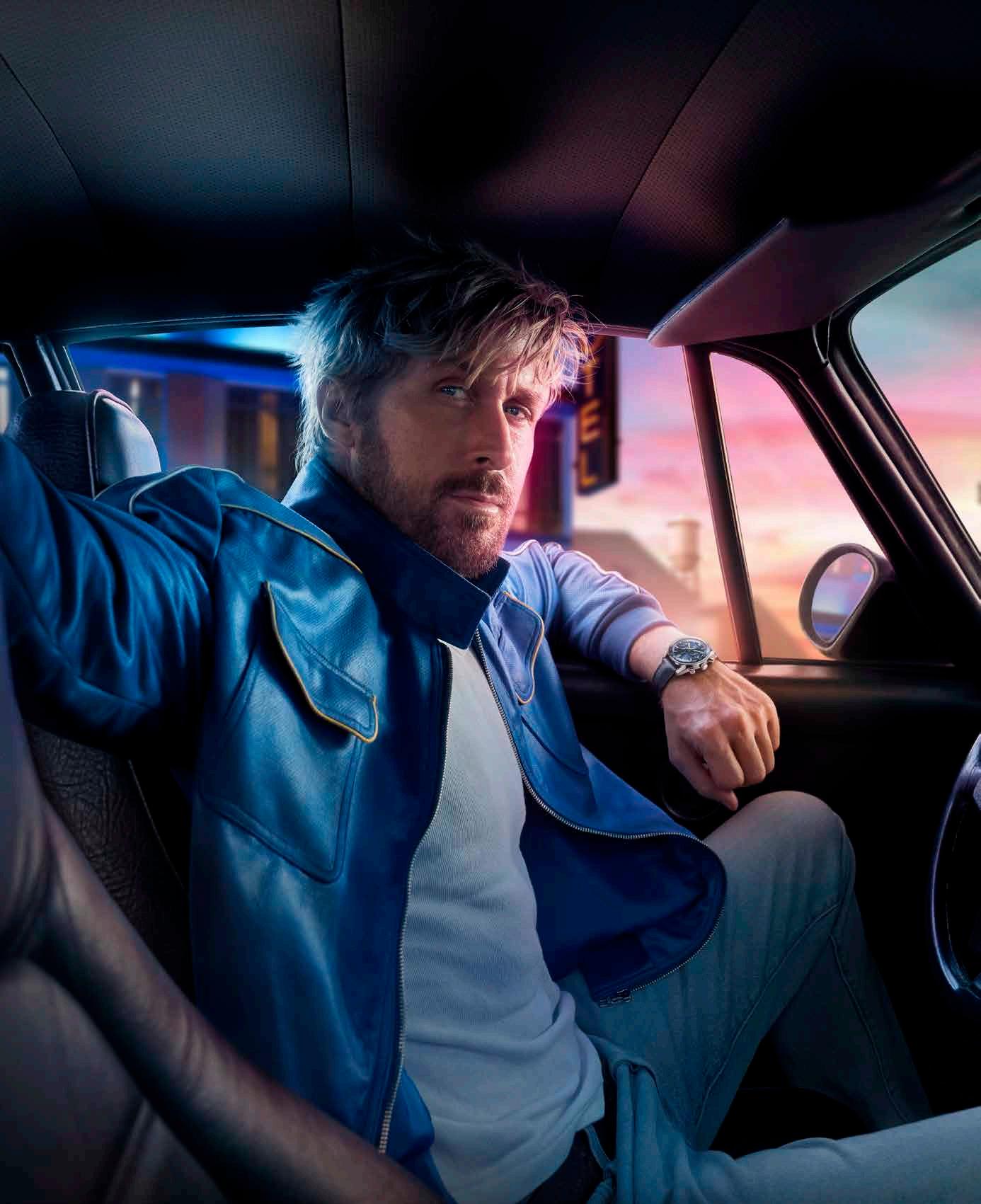

Frédéric, why is the Carrera such an iconic timepiece?
There aren’t many watches with this strong heritage. It was unique from its first launch in 1963. It’s both elegant and sporty, with its links to the Carrera Panamerica. Our 60th anniversary edition is more modern, yes, but you can still recognise many of the original design ideas that are so iconic. I’m really excited about what we have achieved with this release, especially the black [Chronograph] that has a real racing feel with its perforated strap.
Tell us about your partnership with Ryan Gosling?
TAG Heuer is the first brand that Ryan ever worked with, and I think he liked the industry and history of the brand. We really got to know Ryan, his aspirations, and gave him a lot of freedom of expression. I think that’s one of the reasons the result is so exceptional.
What inspired The Chase for Carrera?
We wanted to make something strong with Ryan since the beginning of our partnership; not only use his image, but his talent. I think we really reached that goal. Ryan was involved in the script, the screenwriting, choosing the director and other actors. And he improvised a lot on the set. Initially, we didn’t know it was going to be a five-minute-long movie but, once we had all the footage, we thought it was so exceptional. We needed to share it with the fans of the brand.
Is collaboration something that’s important to you in your work?
It really comes down to our culture. Internally, we have a great product team, design team, engineering team, and that ensure that the best ideas are what cut through. It’s a very collaborative process, from product to campaigns, and we have a lot of energy.
How would you describe your personal horological style?
It depends on my mood, the occasion, what I’m wearing. I’ve been very involved with all of the watches we’re launching this year, and you can see very different visions and styles.
I love the 36mm pink dial Carrera, which is quite exceptional, and the Monza watch we released in January with a carbon case and sapphire open dial. I also wear the Monaco Dark Lord, which I think is very unique because it was so avant-garde when it first launched 50 years ago.
How has your vision for TAG Heuer evolved since joining in 2020?
We had one north star, which was brand elevation. We have seen market dynamics and customers change with the rise of the smartwatch. It has impacted the industry; when people buy a watch now it has to be something very special. They want real meaning. Even if we are having exceptional growth – and last year was our best year ever – that growth comes more through value than volume. Through true innovation.
Why did you want to embrace smart technology with your Connected line? Your watch is part of who you are, it defines your identity. We saw that there was not the same flavour or feeling in the smartwatch market as you could have with a mechanical watch, so we wanted to recreate this emotion. We see it as a new segment that doesn’t compete with our traditional watches; rather it’s a different customer profile and mindset. Our first principle was really having an amazing ergonomic design that would make the wearer feel special. Our users love the variety and the functionality. We also invested heavily into the world of sports with Connected – we have the ultimate end-to-end golf experience on a smartwatch with Tommy Fleetwood, for example. We’re improving year after year.
How do you balance your respect for heritage and quest for innovation?

One of the most important things for us is to talk to the customer of today and also to our collectors. I think we have a responsibility to talk to our young, modern customers without alienating those who already love and collect the brand. This is the balance.
tagheuer.com
There’s something about this time of year that makes everything seem a bit more sprightly. The weather, though inconsistent at the best of times, certainly puts on a show as we head into the warmer months. It’s also a point in time where we suddenly find our calendar is full of soirees, weddings, and summer events.
The fervour around said occasions is often quite intense and exciting, as it finally gives us an opportunity to celebrate, reunite with old friends and to enjoy moments which will live long in the memory. It’s understandable
then, that for these events, we ought to look our best.
We all tend to have a few go-to outfits for such occasions, ones that make us look and feel on top of the world — be it a showstopping cocktail dress or a fine three-piece navy worsted suit, but what about the additional accessories that complete them?
Milliners around the nation spring to action at this time, especially given events like Royal Ascot are merely moments away. A hat, whatever our style preference, is a smart way to take our ensemble to the next level.

As Ascot starts a season of high-profile summer events, we meet the milliners and hatters ready to create your crowning glory
LOCK & CO.
When it comes to hats, there’s no better place to start than Lock & Co. Established in 1676, not only are they London’s oldest hat shop, but also London’s oldest shop in general, as well as one of the oldest family-owned businesses still in existence today. Their latest collection for Royal Ascot features some truly beautiful, antique and iconic styles including the luxurious silk top hat (right) all the way to the exquisite ladies’ pillbox — all of which are appropriate wear for the Royal Enclosure. For formal occasions, there’s no better place to start. »
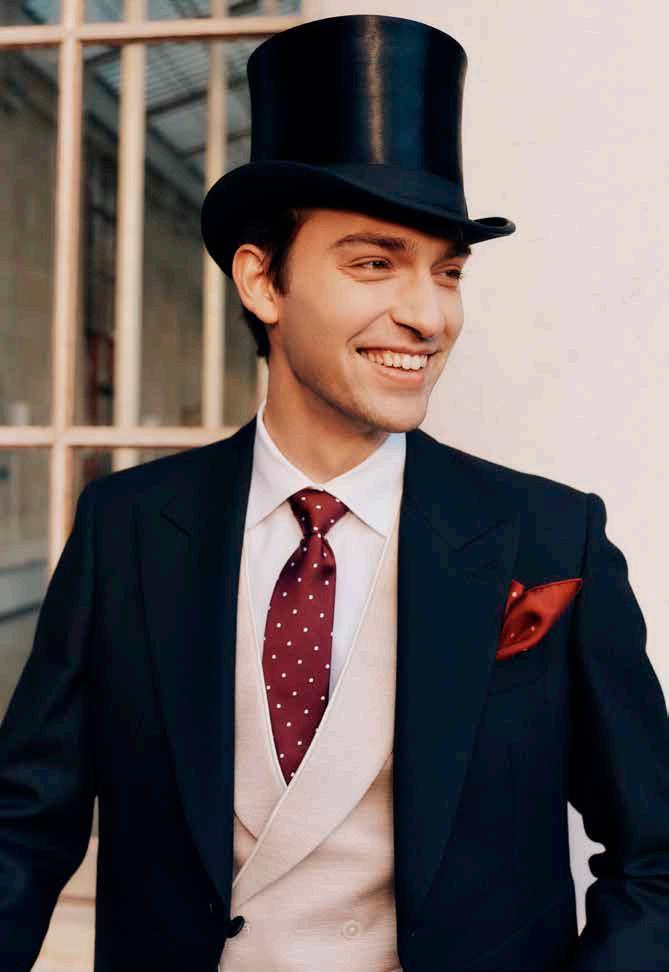

lockhatters.co.uk
Originally from Australia and now based in London, Lisa Tan favours bold yet elegant use of colour (left), incorporated in contemporary style that nods to heritage. It’s a beautiful and innovative fusion and her creations are truly spectacular – so much so that her hats are incredibly sought-after, particularly, given her appreciation and support for horseracing and racing events.
lisatanmillinery.com


Philip Treacy’s haute couture works of art have been donned by everyone from European aristocracy to Hollywood legends and music megastars. Indeed, one of the world’s most famous and in-demand hat designers, he brings classic and traditional styles into the modern era, making hats (as above) that undoubtedly make heads turn.
philiptreacy.co.uk
One brand that’s taking the sartorial world by storm is Singapore-based Hat of Cain. Specialising in authentic Panama hats, Hat of Cain set up in Singapore due to a lack of quality, good-looking headwear that could keep one protected from scorching temperatures. While still a relatively young brand (Hat of Cain was founded in 2012) they have really set the new standard in producing the perfect Panama hats (right) — for aficionados and first-timers — with a variety of weave grades sourced from the finest craftspeople in Ecuador, where this historic headpiece originates.
hatofcain.com

CHRISTYS’
Another titan of millinery excellence, Christys’ is a brand that prides itself in heritage, skill and unrivalled craftsmanship. Best known for their classic fur felt fedoras and rakish trilbies, Christys’ incredibly wide array of styles will ensure that whatever your preference, there’s a hat for you. Opt for their formalwear (right) or go casual with a range of caps – and, if you’re setting off to warmer climes this summer, even give their summer Panamas a whirl.

christys-hats.com

VIVIEN SHERIFF
To own a bespoke piece from Vivien Sheriff (left) is to own a little piece of British millinery history. Exquisite craft, quality in attention to detail and an incredible eye for style… these touchpoints not only describe the brand’s bespoke offering, but also their collections catered to occasionwear — everything from Royal Ascot to the Kentucky Derby.
viviensheriff.co.uk
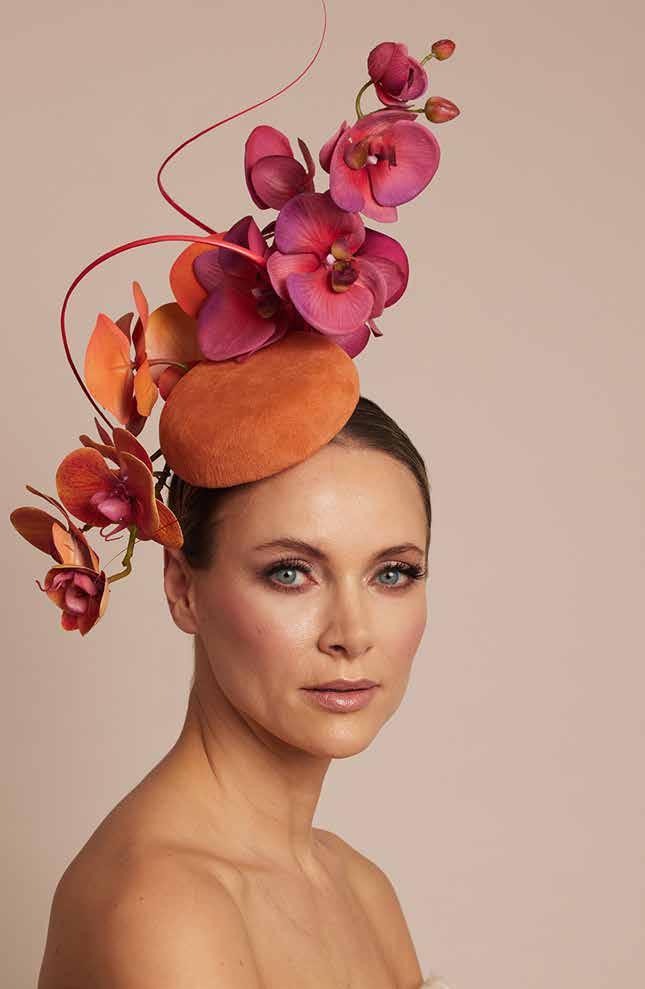
As the UK capital prepares to host the championship race of the all-electric Formula E, we get on the track with some of this year’s season’s most exciting characters
Words: Rory FH Smith


While another season of Formula
One races on with Red Bull’s Max Verstappen sure to claim yet another title, another intense and far more unpredictable battle is nearing its close here in the UK capital.
On 29-30 July, the ABB FIA Formula E World Championship will breeze into London’s east end to crown another champion.

Now in its ninth season, Formula E has brought all-electric racing to city streets around the world since its inception in 2014. With radical new cars this year, the angular Gen3 car is the fastest, lightest and most powerful iteration of the all-electric racer to date – and with all 11 teams able to tweak elements of the car’s formula, as in previous years, the racing remains tight and competitive. Racing all over the world, from Mexico and the Middle East to Jakarta, Cape Town, Monaco and everywhere in between, the latest season of Formula E hits up new cities as well as old favourites.
But one city remains particularly close to Formula E’s heart. Home to the Championship’s first final in 2015, and then again in 2016 – where both were held in Battersea Park – London has always been a firm favourite for the series. After a five-year hiatus, racing returned to ExCel London in 2021, marking a new chapter for Formula E championship as it staged the world’s very first indoor-outdoor race with a track that weaved its way through the convention centre and the roads around it.
Now given the honour of hosting the championship finale once again, London’s calling as all 22 drivers prepare to jostle for position, vying for a place on the podium and, for a few hopeful drivers, the ultimate prize –the championship crown – is within touching distance. Ahead of the grand finale, we hear from the voices behind the championship.
Since Jaguar marked its triumphant comeback to motorsport with an entry into Formula E in 2016, the great British team has clawed its way up the Teams Championship standings from 10th in its debut season to a best-placed finish of second in 2021.
“In terms of where the Championship is this year, you can have an incredibly strong car, drivers and strategy but, if you don’t put it together, it’s difficult to be successful this season as the competition is so close,” says long-standing Jaguar Team Principal James Barclay. “This year is a complete reset. You can’t take anything you’ve done previously into account. We’re all here to win championships. It’s my waking thought every morning and
it’s absolutely why we’re here – we’re on that journey but we’re not at the destination.”
As one of the best-known British teams on the grid, the squad have a lot riding on them for the final in London. Aside from the fact that frontman Mitch Evans and his British teammate Sam Bird regularly battle it out for podiums, the team will feel the full weight of Jaguar’s employees, friends and family behind them as they take on the twists, turns, ups and downs of the ExCel centre.
“Having a race in London as a British team is amazing,” says James. “London is an iconic city and the venue is a challenging one, but for us, racing in the UK and being on the podium would be great. The cars will be fast, we’ll be getting up to some high speeds, so it’s going to be one that requires full focus.” »


Coming into full focus this year was the FIA’s Alessandra Ciliberti who took on the mammoth task of reinventing the Formula E car alongside a host of technical partners and manufacturers.

“We wanted the car to keep pushing the boundaries of innovation, to keep being disruptive and, at the same time, to be purposely built for street racing - so it needed to be lighter, smaller, more powerful and more agile,” says Alessandra.
Sporting a front and rear powertrain for the first time ever on a formula car, the Gen3 can touch 200mph but is also the most efficient Formula E car yet, with more than 40% of

the energy used within a race produced by regenerative braking.
“It’s been particularly enriching to work on the project from scratch with all the stakeholders and seeing all the cars lining up on the grid in Mexico for the first race of the season was quite emotional. I’m sure it will be a similar feeling seeing them finish in London,” says Alessandra.
Already working on what the future Formula E car will be, she’s focused on pushing the existing car to the limit, exploring the possibility for four-wheel drive in some scenarios, all while working on the initial design of the Gen4 car. “The cars will keep being both disruptive and innovative,” she assures.
WE WANTED THE CAR TO KEEP PUSHING THE BOUNDARIES OF INNOVATION... IT NEEDED TO BE LIGHTER, SMALLER, POWERFUL AND AGILE
–– Alessandra Ciliberti, FIAElectric avenue: FIA’s Alessandra Ciliberti (left); Mitch Evans tackles London’s track in 2022 (above); Jake Dennis wins in London (right)
Best known as the man who took the first win of the Gen3 era, British Avalanche Andretti driver Jake Dennis knows a thing or two about electric street racing. Despite only starting his Formula E career in 2021, Dennis has gone on to clinch both podiums and wins in the series, most notably winning two of the four home races he’s been a part of.

“It was one of the hardest races I’ve ever done,” said the British driver, on top of the podium

last time out in London “I’ve never experienced anything like it.”
While Dennis has proved he can navigate his way around the ExCel’s particularly tricky indoor-outdoor track with aplomb, the Brit will be hoping for a similar spell of good luck when it comes to the final this time around.
With a solid points total behind him going into London, Dennis is one of the series’ fastestrising talents. Now with a chance to take the championship crown in the capital, he could be well on his way to motorsport stardom.
London’s already outstanding dining scene is set to become even more remarkable, as new restaurants put these extraordinary chefs at the heart of the menu
Words: Lauren Jade HillThe UK capital has long reflected its rich multicultural identity through the diversity of its dining scene, with the city’s long-time culinary favourites and gastronomic institutions continually being joined by exciting new places to eat.
This year in particular sees a number of worldrenowned chefs make their London debut. Mauro Colagreco of the World’s Best Restaurant 2019, Mirazur, is opening not one, but three restaurants at the soonto-open Raffles London at the OWO; Alberto Landgraf of two-Michelin-starred Oteque in Rio de Janeiro opened Bossa beneath London’s Brazilian consulate in Vere Street on 24 May; and prolific French chef Yannick Alléno is launching Pavyllon London at Four Seasons Hotel London at Park Lane in July. In Autumn, the new Mandarin Oriental Mayfair will see Michelin-starred Korean chef Akira Back open a restaurant (pictured right) and overseeing the hotel’s other dining concepts. Other chefs making an impression in 2023 include Sri Lankan chef, cookbook author and TV personality Cynthia Shanmugalingam, who recently opened Rambutan at Borough Market; and ChineseCanadian chef Jeremy Chan who, along with his co-founder, Nigerian-born Iré Hassan-Odukale, just launched the new Strand site of the two-Michelinstarred restaurant Ikoyi.
Together, these forthcoming and new-to-open restaurants are adding to the excitement of London’s diverse food scene throughout the year. Some of the chefs making an impact on the city’s dining scene in 2023 give us their insight into what they’re bringing to the table. »


“We are creating an ecosystem with different menu offerings and experiences all under one roof,” says Akira Back (right).
Earlier this year, Mandarin Oriental Hotel Group announced that the Korean-born chef and restaurateur would make his UK debut by collaborating with the Mandarin Oriental Mayfair (below) on all of the dining concepts throughout the soon-to-open hotel.


“Whether it be at the signature Akira Back restaurant, ultra-fine dining chef experience in Dosa, late night drinks in ABar lounge or champagne on ABar rooftop with views of Mayfair, there is something for everyone and at all times of the day,” he says.
At the heart of the hotel, the chef’s all-day eponymous restaurant, Akira Back, will serve dishes inspired by his Korean heritage, modern interpretation of Japanese cuisine and influence taken from international travels.
Some of the chef’s greatest hits, such as AB Tuna Pizza featuring umami aioli with ponzu sauce, tuna sashimi, micro shiso and white truffle oil, will be offered in a dining room distinguished by its triple-height sky roof and circular marble staircase leading into space where the décor is inspired by the elements of earth, wind and water.
“I have always loved the London dining scene,” he says. “It is a city that has a distinctive energy and ambiance while being at the forefront of new trends. I am so excited to be a part of this and create something new.” »
akiraback.com
The third most Michelin-starred chef in the world will make his London debut this summer with the opening of Pavyllon London at Four Seasons Hotel London at Park Lane.
Yannick Alléno’s (left) highly anticipated restaurant will bring the chef’s refined neighbourhood dining style (above) to London as it offers a British expression of his signature French dishes.


“Pavyllon will embody the spirit of gastronomy but it won’t be over the top or uncomfortable, it will be a timeless and humble form of luxury,” he says. “I grew up in bistros, cooking or being cooked for, behind countertops and I want to deliver this same experience for my guests.

“The London dining scene is lively, vibrant and home to some really great chefs, many of whom I’m lucky to be friends with,” he continues.
“There is a great amount of mutual respect between professionals on the London dining scene, so when I announced I was opening in London a number of my friends who have restaurants here got in touch to offer advice.
“The people, as well as the city, have this amazing energy. Eating and drinking is a big social thing here in London – there is a massive culture of shared experiences. For 2023, this element of dining and sharing cultural exchanges will only be enhanced.” »
yannick-alleno.com
THE LONDON DINING SCENE IS LIVELY, VIBRANT AND HOME TO SOME REALLY GREAT CHEFS
– Yannick Alléno


Since first opening in 2017, the restaurant of school friends Nigeran-born Iré HassanOdukale and Chinese-Canadian chef Jeremy Chan (left) – Ikoyi – has garnered two Michelin stars and earned a place on the World’s 50 Best Restaurants list.
In December 2022, having outgrown the original location at St James’s, the restaurant reopened in a new and larger space at 180 The Strand. At this new address (opposite) – featuring the interior design of renowned Danish architect and designer David Thulstrup – the two friends aim to push Ikoyi to the next level.
The menu is curated as a personal expression of British micro-seasonality through the chef’s lens of spice and bold heat.
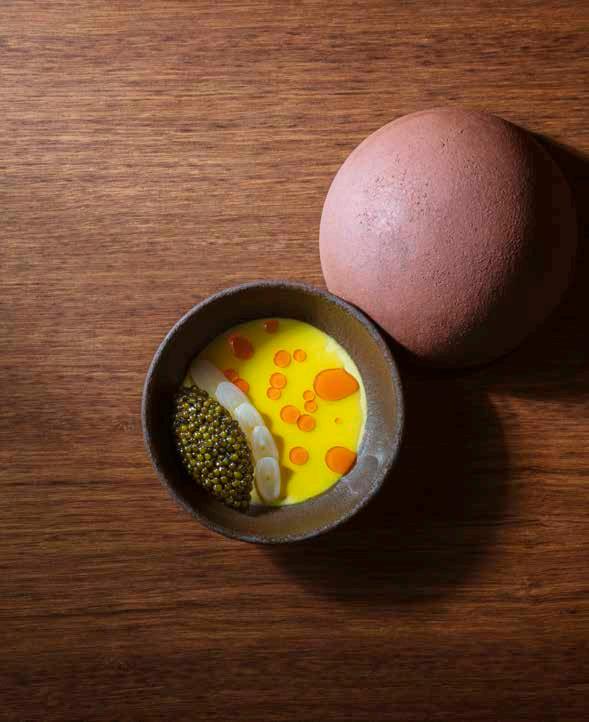
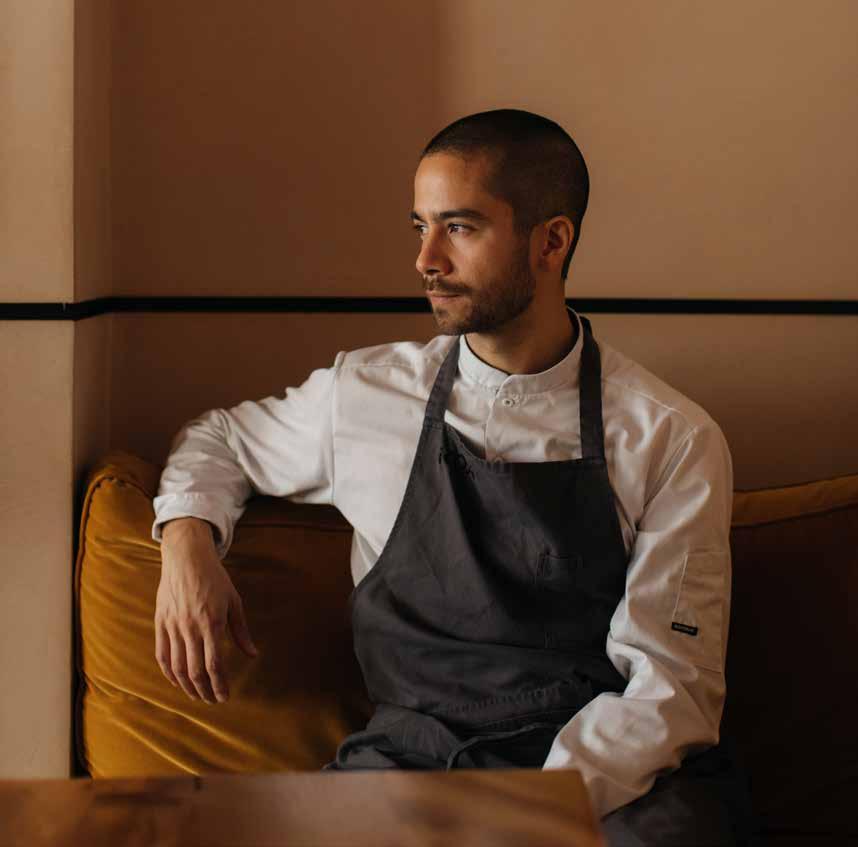
“Ikoyi at 180 The Strand is a completely new restaurant,” says Chan. “The aesthetic is different. We have a new style of service and we are using new cooking techniques. The menu is longer – 22 servings in the evening, including snacks and petits fours.

“The intention behind every dish is deliciousness, but I want guests to feel the intensity and that can push people in different directions. Spice is part of our weaponry. It’s not just a quick hit of chilli; it has a rounded depth to it. It gives you that warm, comforting feeling. That’s what is unique about Ikoyi.” » ikoyilondon.com
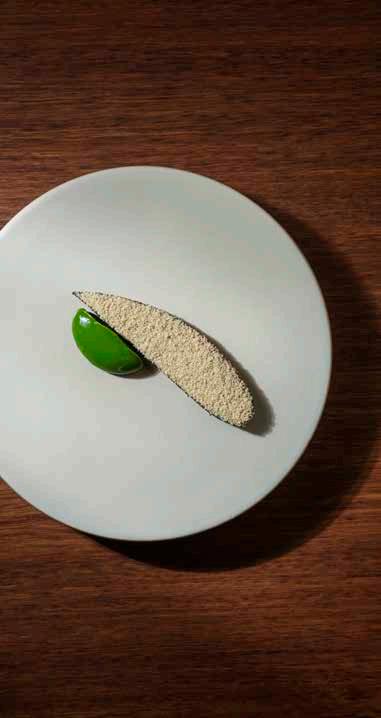
This March also saw the launch of Rambutan, the debut restaurant of Cynthia Shanmugalingam (right), in London’s historic Borough Market. This restaurant is inspired by Sri Lankan cooking, focusing in particular on the food of the chef’s ancestral home, the ancient Tamil region in the North of the island, and it is the product of years of cooking and collecting recipes from family members and chefs who have shared their culinary secrets.
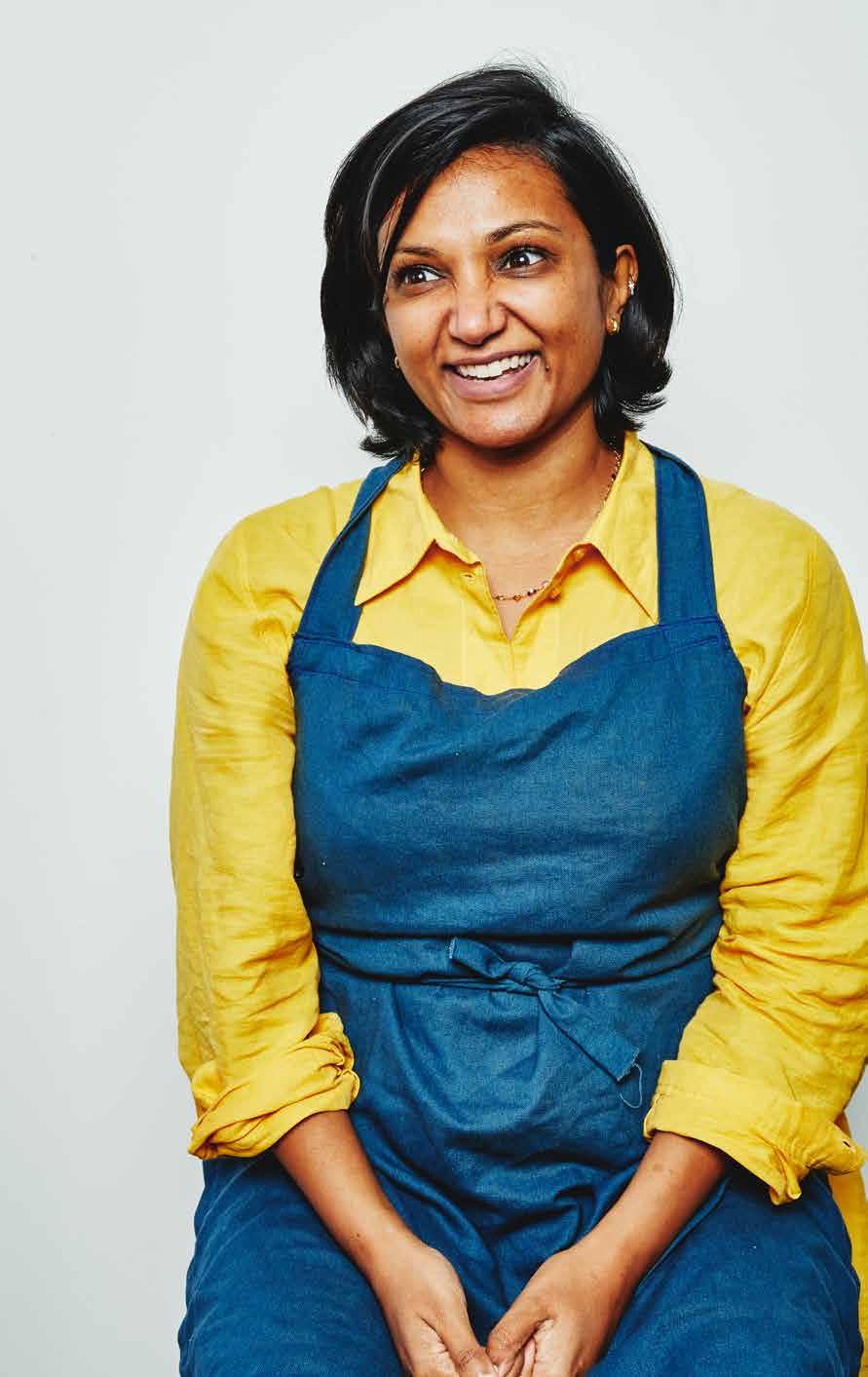
Ultimately, Rambutan presents a fusion of both old and new recipes, naturally using ingredients from Borough Market as well as Sri Lanka, to make heritage dishes with an immigrant twist.

“We’re cooking on fire, the way my Tamil aunties do in Sri Lankan village cooking, so the rotis will be smoky, the dosas crispy and there will be lots of grilled Jaffna-spiced mutton chops and seafood curries cooked over fire,” she says.
At Rambutan, the chef’s dishes are served in a space pairing bright colours with dark woods, also displaying the work of Sri Lankan artists, and gravitating around a green marble kitchen counter.
“I think London is about to get really buzzy with lots of exciting new openings, many of them by chefs from immigrant backgrounds. It feels like we’re about to see a wave of joyful, big-hearted cooking that celebrates London’s communities.”
rambutanlondon.com

As The Singleton releases its most decadent expression yet, neuroscientist Katherine Templar Lewis reveals all about the sensory science behind the scotch – welcome to sensorial maximalism
Whisky has long been known as the water of life, but with The Singleton’s release of the 40-YearOld Single Malt Scotch Whisky – the third and final of a series of exceptional releases – the Glen Ord distillery has taken the restorative roots of auld uisge beatha to the next level with the creation of a new science-led sensory tasting experience.
Partnering with neuroscientist Katherine Templar Lewis (pictured, right), The Singleton explored a new theory based in neuroaesthetics – sensorial maximalism – which enhances and focuses each of the senses in order to achieve superlative taste for this decadent blend, created by malt master Maureen Robinson.
“Sensorial maximalism has been really exciting,” says Katherine. “The starting point was this incredible whisky, The Singleton 40-Year-Old, which has an incredibly rich, deep flavour profile.” Katherine’s work was used in the development of an immersive sensory gallery experience in Shanghai, called The Rooms of Maximalism, for the launch of the expression in April, but has also created a tasting ritual that can be explored at home to maximise the senses through external experiences – such as curating touch, sound, and sight.
“What surprised me about The Singleton 40-Year-Old was the huge journey you go on when you taste it, as all these different flavours unfold. It was really exciting to translate that

Words: Michelle Johnson

physically,” she says. “We wanted to create experiences that amplify the flavour profile, not just in terms of the flavour itself, but the emotional experience as well. Taste and smell are intrinsically linked, and really powerful emotional tools in terms of memory formation and wellbeing. These senses bypass part of the brain that slows sensory processing, so you get an instant reaction to these senses as it hits the brain’s limbic system, which is the seat of our emotions. None of our other senses are quite as powerful in eliciting emotion and memory.”
The Rooms of Maximalism saw guests journey through rooms that delivered precise sensory stimulation before enjoying the first global tasting of the 40-Year-Old. Some of the sensory stimulants included the unveiling of a largescale physical artwork by Zhou Yilun, areas of sensory deprivation, an ASMR soundscape designed by conceptual artist Moodsonic, and flowing digital art by Found Studio designed to induce a flow state in viewers – all this alongside a range of tactile and textural prompts throughout the exhibition.
“What I love about neuroaesthetics is you can start to shape experiences that are going to have this positive impact on people. Shanghai is the perfect example of that, working with these talented artists who actually explore the world in a similar way to scientists,” says Katherine. “I think artists and scientists are more similar than we think: we just use different tools to achieve understanding.” »

The flavour profile of The Singleton 40-YearOld, the finale in the distillery’s Epicurean Odyssey series, is mellow on the nose with fruity top notes of dried apple, plum and spicy oak beneath. With a light to medium body, it is smooth and lightly waxy on the palate. The taste starts sweet, vibrant and very fruit, with sour plums and salt following mid-palate. The complexity of the flavour emerges with impressions of chocolate-covered pears and caramelised tropical fruits, with slow-building pepper, spice and a hint of smoke, before a long, deep-flavoured finish.
Maureen describes the scotch as “one which I’ve thoroughly enjoyed crafting and have drawn on my own personal journey of flavour from my career as a whisky maker”.
“At the end of this very extensive secondary maturation we sought out specially selected Ron Zacapa XO casks for a final indulgent finish to the whisky, which deliver an intensely rich, fruity and smooth finish to bring deep notes of dark chocolate. The result: a whisky that epitomises my desire to seek out new flavour through craft, and a whisky at its most maximal,” she says.
Katherine’s interest in sensory exploration began early in her career. The ‘renegade scientist’ started in psychology before moving into neuroscience and the emerging field of neuroaesthetics. “Neuroaesthetics is basically looking at how we are impacted by the multisensory world around us,” she explains. “How does light, sound, taste and smell impact our brain and body?”
The field began with research into sound but has expanded into other senses. In addition to scientific research, Katherine also works with major brands including Google, Nike, EdenLabs and Goldsmiths to curate user experiences. “Experience building is the core of what we do because so much of the science gets stuck in the labs and then it doesn’t really help people,” she says. “What’s amazing with taste, especially, is that it’s a sense that we can be really playful with now that we understand how it starts to work in the brain.”
So, how can we create such an experience at home? Perhaps surprisingly, it’s far easier than one might believe.
“We know that there are certain things we can do to enhance and change how we experience flavour,” Katherine says, citing Gastrophysics author Charles Spence. “Our expectations enhance flavour – eating from a red plate makes food taste sweeter, while a blue plate makes food seem saltier. Similarly, we can enhance our tasting experience by using other sensory cues. We can prime our tastebuds with textiles,
sounds and artwork to genuinely enhance the flavour in the mouth and allow us to absorb and consciously register more of it.“
The main thing is to really ground ourselves in the body, because we spend so much time in the modern world disconnected from our body – bombarded with messages and notifications from the outside world,” she says. “The first step to any sensory tasting is to close your eyes and really focus on your different senses, take deep breaths in and out, slowing your breathing and resetting your system. Then we start with steps to bring out these flavours, starting with touch.”
Katherine recommends selecting the heaviest smooth glass or drinking vessel possible to enhance the element of luxury. “Interestingly, the heavier and smoother the glass, the more value we naturally attribute to it – it literally gives weight to the occasion,” she says.
Colour also influences the brain, with warmer colours like red and orange bringing out sweeter notes of vanilla and fruit, as well as playing into our cultural associations with bright colours being happier. Finally, listening to ASMR or your favourite music acts as a sensory reward, encouraging the brain’s production of the “feelgood” hormone dopamine.
If this sounds similar to mindfulness or meditative practises, you wouldn’t be wrong.
“It’s really interesting to pick up on that, because one of the key goals of meditation is to get our brain rooted in the present and in our bodies. There’s a lot of research now that indicates we feel emotion in our bodies, not in our brain – the quickening of our heart, excitement in our stomach – and the more we disconnect from our body, the less we connect to our sense of self. The brain gets stuck in two states: the pain of the past and the fear of the future,” says Katherine.
“But, equally, when you’re in that state of worry, you’re not as connected to your senses. There are some really interesting parallels between meditation and our tasting rituals that bring us back to our senses. Rituals create meaning and enhance our wellbeing.”

It will be no surprise to whisky connoisseurs that the occasional dram is good for the soul, and Katherine’s mindful, maximalist ritual is a delightfully calming complement to the expression, further enhanced by a series of visual artworks and soundscapes available online via The Singleton’s website.
“The Singleton 40-Year-Old is a perfect centrepiece in that way, because its creation is a science as well as an art and, hopefully, with the at-home ritual, those elements will now be even more enhanced.”
thesingleton.com
– Katherine Templar LewisSensory maximalism: The flavour of The Singleton 40-YearOld (inset) is amplified through the five senses; Art by Found Studio was designed to induce a flow state at The Rooms of Maximalism exhibit in Shanghai (right)
NONE OF OUR SENSES ARE AS POWERFUL AS TASTE IN ELICITING EMOTION AND MEMORY
Step 1. The Palate Cleanser
Find yourself somewhere quiet and calm. Close your eyes and take a deep breath, in and out.
Step 2. The Pour
To bring out the velvety rich sensation of The Singleton 40-Year-Old, find your smoothest and heaviest glass to serve.
Step 3. The Context
Sight: What colours are around you? Depth and warmth of colour will add to the feeling of richness and decadence.

Sound: Compositions that layer sound and melodies increase dopamine production in the brain. Enhance your experience with your favourite song or listen to The Singleton’s curated soundtrack via their website.
Touch: Make sure the temperature around you is warm and comforting. Soft, luxurious fabrics can enhance the taste experience.
Scent: Smell the back of your hand to reset your sense of smell. Wearing perfume may alter your taste perception, in a way that is uniquely yours.
Step 4. The Primer
Now grounded in our bodies, it’s time to take another three deep, slow breaths in, and out to close out any external distractions.
Step 5. The Taste Experience
Finally, we are ready to take our first sip. Bring your full awareness to the taste, knowing that all your other senses will be contributing to the full experience.
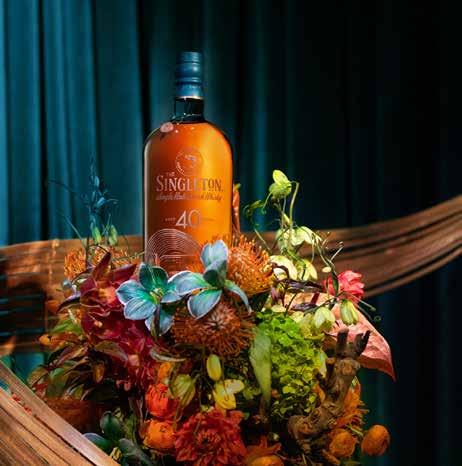

As Finland tops the rankings as the world’s happiest nation for the sixth consecutive year, we spend a week in the wilds of the country’s islands to discover what makes this destination so appealing
Words: Tessa Crowley

Heading out with Sidetracked Adventures and one of their trusty wilderness guides, I’m one of five women ready to undertake a week kayaking the Finnish archipelago. While camping trips were a regular feature of my childhood holidays, faced with the prospect of six nights under canvas I’m unsure how much of its charm may have worn off in the intervening years. It transpires that my worries are unfounded and, by day two, I’ve ditched the tent entirely, in favour of waking up on an incredibly comfortable mattress of bracken in the fresh Finnish forest to the sound of lapping waves. I’ve not slept so well in months and, rather than needing a desperate dash for a strong caffeine fix, feel alert as I opt for a quick stretch and pick my way down to the shore for a morning swim instead.
Despite being the world’s largest, the Finnish archipelago itself is relatively unknown. A collection of more than 50,000 beautiful islands tucked away in the Baltic Sea, I discover the waters are surprisingly fresh and the tides gentle, making it an ideal destination for both kayaking novices and wild-swimming devotees.
From our kayaks, drifting along under the sun, we point out the odd bird or landmark as we paddle; but it’s the flora that captures our enthusiasm – and taste buds – when tiny black jewel-like fruit are revealed as an abundance of bilberries on an uninhabited island.
While much-reduced levels of caffeine quickly diminish my jitters, there’s little doubt that the drifting days with no alarms, no news, and no cables have an unmistakable impact too. With signal scarce and zero wifi, my phone becomes a glorified camera; even my much-used notes app is shelved in favour of an analogue notebook and pen. I’m astonished to discover how long each day feels when not rushing from one task to the next, reliant on calendar alerts, alarms, and timers to get me through.
I struggle to recall when I last spent a whole day, let alone a week, not at the beck and call of my mobile. A sad but fundamental reality of modern life, I find that, without my trusty tech, I initially feel bereft. I catch myself reaching repeatedly for my phone, as though a quick dopamine hit and social media doom-scroll might be preferable to the literal island paradise I’m inhabiting. What am I hoping to find within the confines of the screen that could compete?
As I rediscover my senses, I mull over what a week away is doing to my brain. Colours seem brighter, I’m noticing new textures, scents and sounds, and generally feel more engaged with my surroundings as my threadbare concentration returns.
When not out on the water, our days are spent swimming, reading, taking sauna, or chatting among the group. The satisfaction of an hour spent sunning on a rock; the thrill of returning to printed maps to pick our route, skilfully managed by our knowledgeable wilderness guide Chris; and the slow process of jotting down my thoughts at the speed of my own handwriting, are all indulgences I forgo day to

day. In our fast-paced world, a week off-grid feels like an impossibly indulgent luxury – a wonderful yet forbidden escape – and the sense of freedom far surpasses my expectations.
As the days progress, entirely self-sufficient, we find our rhythm, deciding on a whim how far to paddle, adjusting our course based on energy, morale and water-needs as the day unwinds. Coming across a sauna two days’ paddling from Helsinki, we discover how essential sauna culture is in the country, which contains 1.8 saunas to every inhabitant. The reality of this statistic becomes apparent when, just days later, we stumble upon a second, miles from supposed civilisation.
Given the remoteness of our journey, interactions with locals are few, but the lure of the sauna clearly beckons, and we bump into another group who’ve come in by boat. Arriving second, they wait their turn, leaving us to prepare logs and curl thin strips of bark; restocking what we’ve used in readiness for the next visitors, so the all-important sauna fire can be started upon arrival. Once the wood-fire has heated up, we embrace the ritual with glee; basking in the heat until we can’t bear the humidity before making a mad dash out of the door, across the rocks, and into the relief of the refreshing ocean.
At the end of a week in this inhabited wilderness, I understand why the Finns rank themselves in that happiness top spot. The

enjoyment I found in my time there was not loud but rather a quiet contentment with life. Surrounded by nature, with an incredible infrastructure supporting outdoors pursuits, it’s easy to tune in to the natural world and have an awareness of self, of community and culture, and of the country’s innate beauty.
While my week in the wilderness may not have been life-changing in the sense of a grand adventure, it did push me out of my comfort zone and provide a renewed appreciation for the simple pleasures of life. I feel more alert, well-rested, and even my somewhat evasive attention has improved. As I head back to the daily grind, I vow to be more Finn – taking some of this tech-free time and quiet calm back into each day, striving for the contentment and tranquillity I found on the islands.
sidetrackedadventures.co.uk
Happy camper: Kayaking the Finnish archipelago with Sidetracked Adventures; a remote sauna (above)




It’s no understatement to say that the skincare industry is rapidly evolving, and that’s due in no small part to the empowerment of beauty customers. Indeed, backed by the power of digital discourse, it might seem like the modern shopper has all the skincare information they need at their fingertips. With a quick web search, there are skincare recommendations for every skin type and goal imaginable, and seemingly ever greater choices as new brands launch with growing regularity.
Skincare discussions on social media, for example – where Instagram and TikTok videos achieve millions of views – has even driven the rise of a new type of customer: the ‘skintellectual’.
These skincare aficionados have even helped democratise the industry, by placing the sharing of information in customers’ hands. No wonder then, according to Brandessence Market Research, that by 2026 the skincare industry is projected to generate an impressive $180bn.
Yet, while the beauty industry’s tradition of ‘top secret’ formulas and ‘miracle solutions’ is ending, key questions remain: Why do individuals still struggle to find products that work for them? Why does confusion continue? And to what degree are we replacing limited information with inaccurate information? »

The ‘Skintellectual’ movement is celebrated for democratising beauty, but are we truly better educated about skincare?

‘Clean’, ‘natural’, ‘medical-grade’… the skincare market is still dominated by buzzwords and, while they may appear to make product categorisation easier, in practice they mean very little. While the day-to-day customer shouldn’t need a science degree to understand their skincare routine, there’s a growing distance between the complexity of cosmetic science and beauty’s one-word darlings.
That’s especially true of those listed above because they lack legislation and have definitions that are consistently ill-defined.
Even so, the digitalisation of beauty is fuelling their use, powered by search engines that require you to use the right keywordto effectively search for products online. This only rewards the use of reductive language to ensure brands get noticed; even if this oversimplifies and misinforms.
Segregating skincare into ill-fitting boxes also creates false conflicts between different beauty ideologies, so, while information has become more freely available, skincare dialogue has also become dichotomised.
Consider synthetic ingredients, which have been demonised by their direct comparison to ‘skin and planet-loving’ naturals, despite labbased ingredients powering new innovations and advancing sustainability goals. After all, while natural beauty requires large acres of farmland to grow, synthetics can be engineered without picking a single flower. That’s a conversation worthy of much greater celebration.

Clean beauty is another key example. For something to be ‘clean’, there’s the assumption that something else is dirty, or, worse, unsafe.
Hence, the boycotting of skincare ingredients as ‘toxic’, or the marketing of ‘no nasties’ lists from ‘chemical-free’ brands.
Fundamentally, all ingredients are chemicals, so the term ‘chemical-free’ should have been quickly discarded as fearmongering. Yet, it still prevails. The reason, if you pardon the pun, is frighteningly simple: fear is one of our strongest emotions, meaning a ‘better safe than sorry’ approach can feel comfortable, even if it’s inaccurate.
Moreover, considering it’s legally required for skincare products to be thoroughly tested before they are sold, the enduring suspicion that brands are putting profits first [swindling or even harming customers] only draws attention away from finding tangible skincare solutions.


Even the biggest hero ingredient to emerge from the ‘skintellectual’ movement has not been spared from oversimplification. ‘Retinol’ is now one of the most searched-for skincare terms, powered by discussions around its wrinkle-smoothing abilities. Yet, ‘retinol’ itself is a buzzword term.
‘Retinoids’ is the more accurate categorisation for the group of vitamin A derivatives used in skincare, with different forms ranging from prescription-only retinoic acid, down to more stable yet less potent retinol esters. These forms can differ widely in effectiveness and side effects, but discussions remain around ‘retinol’ as a catch-all term –without acknowledging the nuance.
‘Retinol’ hype also overlooks one important fact concerning skincare scientific research: studies on ‘gold-standard’ ingredients are predominately conducted on the individual element, without any context of how the specific
form, percentage, and interaction with other components within a product affects results. It therefore requires more than knowing ‘retinol’ is good for wrinkles to truly understand what products may help you achieve your goals.
It’s clear that even with fast-paced development in the skincare industry, greater access to information has not necessarily led to better-informed customers. Luckily, the first step toward a solution is that simple acknowledgment. By taking time away from the constant feed of information we receive online, we can refocus on the quality not quantity of the skincare ‘education’ we have access to. Simply put, try to remember the three ‘Rs’: research, respect, and real transparency.
The best research to look for is final formulation clinical trials, conducted on a
Beyond beauty: Today’s skincare customer is rightly demanding more for their money and stepping away from buzzword-based beauty trends
range of individuals in the appropriate age range and skin type. Another ‘R’ – the recency of studies – is also significant as research is constantly evolving. There’s even more creditability if the research is independent, to limit bias.
Significantly, brands should want to highlight this data, so don’t be afraid to ask for it and, in fact, a good rule of thumb is to ask a research-based question to any skincare brand you are considering. Is it open and well-balanced, or vague and illusive? True empowerment is knowing the brands you spend with treat you with respect.
Certification can also help cut through the noise of the skincare industry’s own hype, especially in the ‘organic’ and sustainability space where greenwashing can abound. (After all, ‘organic’ is another unlegislated term). Look for the logos of organisations such as Soil Association, BCorp and Leaping Bunny on accredited products, for independent, evidence-based analysis of a brand’s sustainability credentials.

Bear in mind, though, that research and accreditation also generate costs, which are often passed down to customers. It’s important to challenge brands to be transparent about this aspect of skincare marketing, while avoiding the temptation of placing value above efficacy. Particularly, while the rising popularity of ‘dupes’ – cheaper alternatives to popular products – can seem exciting, don’t be blinded by similar packaging, where often the core formula bears little resemblance.
Consequently, with the skincare customer, quite rightly, demanding more for their money, it’s time to step away from the buzzwords and create a more open skincare dialogue. By avoiding polarisation, and taking a balanced point of view, we can all make better-informed decisions.

Launched in 2021, this London-based Frenchmade cosmeceutical brand was co-founded by microbiome and epigenetic scientist Tule Park, who realised many treatments for skin issues such as acne predated genome and microbiome sciences (epigenetics is the study of how your behaviours and environment can cause changes that affect the way your genes work). Skin Diligent’s cleansers, serums and supplements are designed for any skin issue, with the brand’s new Cellular Hydration Serum

This Swiss skincare brand focuses on the use of cellular extracts in skincare and bodycare products designed to revitalise skin exposed to the stressors of modern living – from pollutants and UVA to diet and stress. Cellcosmet’s signature ingredient – CytoPep Cellular Extracts – is composed of collagen, fibronectin and actin, with all products evaluated in clinical studies. For a full experience, try the newly launched Swiss CellSpa Experience at Ouronyx in Mayfair. cellcosmet-cellmen.co.uk

Skin Bureaux was founded by aesthetic doctors Charlotte Woodward and Victoria Manning, known for their River Aesthetics clinics in Bournemouth, Lymington and London’s Harley Street. Using hero ingredients such as CBD and CBG, Victoria says the brand is the “first doctor led antiinflammatory cosmeceutical ranges”, with serums and creams for day and night.

skinbureaux.com
Dr David Jack was inspired by clients at his Harley Street clinic to create a skincare regime to promote skin health from the inside out. Launched in 2018, the range of home peels, serums, moisturisers and supplements products target a variety of skin concerns – from acne to healthy sleep – through a variety of active ingredients. Don’t miss the new Blue Face Peel, which blends ceramides, niacinamide, azelaic acid, hyaluronic acid and vitamin B5 to tackle dry, sensitive skin.

drdavidjack.com
SBTRCT
Certified B Corp and awarded the Vegan Trademark, SBTRCT is a zero-waste skincare brand that offers solid fundamentals –including solid cleanser, exfoliator, moisturisers and serum – that are free of plastic, palm oil and water. The brand’s retinoid and vitamin C solid products are both world firsts – perfect skincare for the eco-conscious.


sbtrct.co.uk
SENSAI
Japanese brand Sensai is famed for its indulgent skincare and cosmetic ranges, with its Saho cleanse and moisture ritual inspired by ancient tea ceremonies. Researchers found that weavers of Koishimaru silk had “youthful silky hands”, and discovered the silk promotes the production of hyaluronic acid – thus, a skincare revolution was born. Now offering digital counselling to match product to individual’s skintype, this is a true spa experience in the home.
sensai-cosmetics.com

With breathtakingly diverse landscapes supporting an abundance of wildlife, Botswana offers some of the most unique safari experiences in Africa
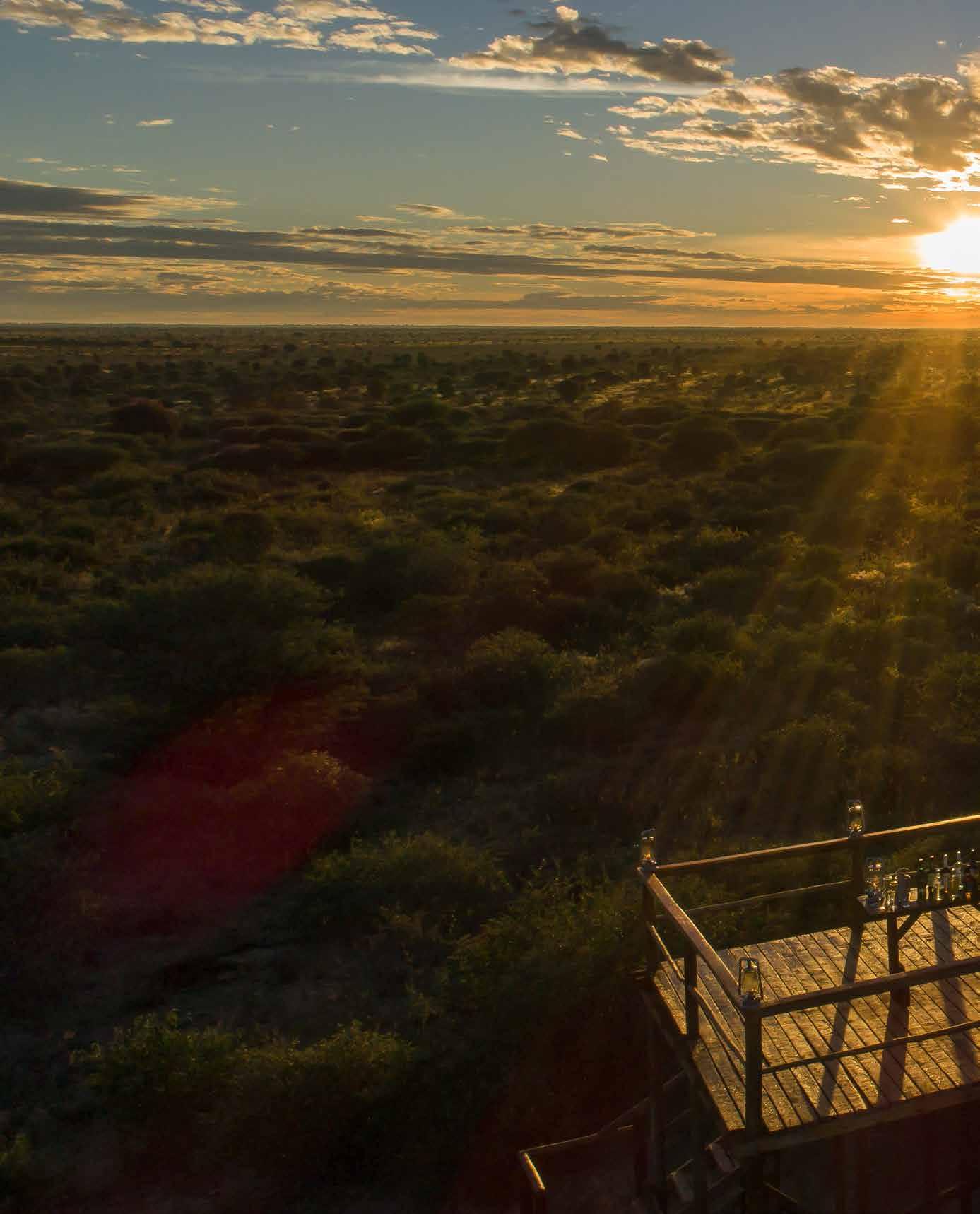 Words: Lauren Jarvis
Words: Lauren Jarvis
I’m sitting on a blanket stretched out over scrubland when the first inquisitive meerkat pops out from its burrow, scampers towards me and climbs onto my lap. Soon, I have a family of six around me – using my leg, then my shoulders and eventually even my head –to stand and make their sunrise surveillance of Botswana’s Makgadikgadi Pan in the heart of the Kalahari Desert. I’m glad to be of service: this

is an unforgiving land roamed by lions, hyenas, jackals and soaring eagles, all of which would happily munch down a meerkat for breakfast.
As the tallest thing around (standing at a diminutive 5ft 2in – this may be a world-first, for me) the meerkats are using me as a convenient lookout and, with the coast clear, scramble down and set off at pace to forage for grubs, frogs and their favourite delicacy, scorpions. »
A visit to see the colony of 13 habituated, but completely wild, meerkats is one of the highlights of a stay at the legendary Jack’s Camp, which lies on a lush palm island overlooking one of the largest series of salt pans on Earth. A decadent oasis in the wilds of the Kalahari, Jack’s is managed by the Natural Selection safari company, but sprung from the imagination of pro-hunter-turned-conservationist, Jack Bousfield, who fell in love with the region during a hunting expedition in the 1960s.
With a passion for adventure and a knack for spinning a campfire yarn, Jack survived no fewer than six light aircraft crashes but sadly succumbed to the seventh, leaving his equally intrepid son, Ralph, to bring his father’s dream to life.
And what a dreamy tribute it is: part safari camp and part natural history museum, Jack’s is a cornucopia of delights, echoing Africa’s Golden Age. Extensively revamped by the team during the tourism-free months of the 2020 pandemic, nine vast 270sqm tents offer overhead cooling systems, private plunge pools, swinging daybeds and indoor and outdoor bathrooms, decorated with lush textiles, dark wood and Middle Eastern
lanterns. Beyond, a huge, tented pool pavilion, chandelier-lit dining room, Persian tea tent and opulent lounge bedazzle with artefacts and antiques.
“Don’t forget to look up,” says my guide, Desmond, before I crunch, wine glass in hand, across the lunar landscape of the Ntwetwe Salt Pan at sunset. Much of the time on safari is spent bumping around in a Land Cruiser, so walking in the wilderness that surrounds Jack’s is a thrill. On my morning game drive, I’d witnessed lions devouring an aardvark and seen the tracks of brown hyenas, so making my own prints in the crystalline crust, I’m on high alert, despite being able to see for miles. The Kalahari winds play with my hair, as the horizon burns orange, throwing fardistant palms into spiky silhouettes. By the time I return to the safety of Desmond’s fire, the stars are out; constellations spangling the velvet drapes of the sky, which fall 360 degrees around me to the horizon.
At Dinaka, a private reserve and camp on the northern fringes of the Central Kalahari Game Reserve, run by safari company Ker & Downey



Botswana, the “green season” has seen the desert ecosystem spring to life. One of the most biodiverse ecosystems in Southern Africa, over 200 species of birds, including kori bustards and crimsonbreasted shrikes, can be seen from the reserve’s skilfully hidden waterhole hides, which also offer a front-row seat to watch magnificent greater kudu, eland and oryx antelopes taking their morning drink. Landing on the dust strip at the ironically signposted ‘Dinaka International,’ an elephant grazes nearby and, as we pull into camp, the staff welcome us with a song in the national language, Tswana. With eight beautiful ensuite tents, each on a raised deck with views over a water hole, the camp sits at the heart of the action.
Lions call nearby in the night, warthogs wander through at breakfast, and in front of the dining and lounge deck, an incredible phenomenon takes flight. After good rains and buoyed by an abundance of grass seeds, thousands of queleas (small finch-like birds) fill the skies, their swirling murmuration watched by eagle-eyed lanner falcons and yellow-billed kites, waiting to swoop for an opportunistic meal.
This remote realm has sustained the indigenous people of Southern Africa, the San – or Bushmen – for tens of thousands of years. »
Wild reserve: Accomodations at Jack's Camp (above and right); wildlife in Central Kalahari Game Reserve (top left). Previous: views of the Reserve from Dinaka



One of the world’s oldest surviving cultures, it’s believed 300,000 San lived as semi-nomadic hunter-gatherers in the region at the time of European colonisation, which took a tragic and deadly toll: today, 100,000 remain, with the majority (between 55-65,000) living in Botswana.
Dinaka offers guests the chance to walk with the San, to learn how they hunt, forage and strive to keep their culture alive on their ancestral lands, which successive governments vested in mining interests have tried to take away. “We have adapted to manage our traditional and modern ways of life,” my San guide, Xhase, tells me. “Our ancestors are with us, helping us through the difficult times: if we are with them, everything is fine. We won’t forget ourselves, or who we are.”
SHINDE
So much of Africa offers incredible game viewing, but what sets Botswana apart and above is its diversity of landscapes and experiences. While the Kalahari Desert covers 70% of the country, Botswana is also home to the world’s largest inland delta, the mighty Okavango, which offers wildlife encounters like nowhere else on earth.
Flying over this watery wonderland in an open-sided helicopter, its scale and breathtaking biodiversity comes into view. Below me, elephants, giraffes and herds of red lechwe roam, while flocks of ibis cast shadows over the myriad islets, and silver rivers snake like veins, bringing life to the land. Here, I stay at Shinde, one of the
country’s first safari camps run by Ker & Downey Botswana, with a prime position on the edge of Shinde Lagoon.



Rebuilt in 2020, Shinde’s eight stylish ensuite tents slumber beneath ebony and mangosteen trees, a pool delivers refreshing afternoon dips, and a treehouse-style lounge area and deck offer drinks and dining under the stars. My guide, Robbie, asks me what I’d most like to see and, like a personal genie, grants every wish.
On our first drive, a leopard: striking, selfassured and so close I could have stroked her; on the next, a mother lioness and cubs, crunching their way purposefully through a kudu; and on another, a pack of elusive African wild dogs, lazing after a hunt in the afternoon sun.
The Okavango yields the chance for boat safaris too, and Robbie skilfully navigates past herds of territorial hippos and a mammoth bull elephant, belly-deep, feasting on feathery papyrus grass, even slowing to rescue a floundering chameleon, swimming unsuccessfully against the flow. For sundown, we switch to a Mokoro, a dugout canoe traditionally used in the Delta, punted by a boat man with a ‘ngashi’ or pole. Sitting low in the water, the canoe glides softly through grasslined channels and lily-covered ponds, while dragonflies zip and tiny green reed frogs tinkle with bell-like calls. Dusk turns all to gold as we arrive back at Shinde, and the Delta’s eternal songs play on into the night.
audleytravel.com; kerdowney.com


With two magnification options, 8x and 10x, these compact, ergonomic binoculars will zoom you even closer to the action. Available in green and burnt orange, they’ll connect to your smartphone with an optional VPA variable phone adapter, too. swarovskioptik.com

Wildlife filmmakers and conservationists, Dereck and Beverly Joubert, are based in the Okavango Delta, so you’re in safe hands with their new, sustainable collection of safari wear for men and women, inspired by 1920s explorers. greatplainsconservation.com

OHELO
Cut down on single-use plastic with a durable, ethically produced reusable bottle from Ohelo. This is one of the only insulated bottle brands in the world to be completely lead free, and 5% of company profits help to support sustainable charities. ohelobottle.com
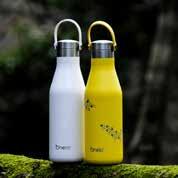
RHINO

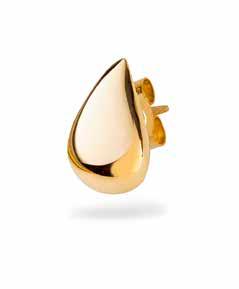
Inspired by a meeting at South Africa’s Kariega Game Reserve with Thandi, the survivor of a brutal rhino-poaching attack, Sarah Cobden-Ramsay founded Rhino Tears, with all the profits supporting rhino conservation charities, including Helping Rhinos. rhinotears.org
INCOGNITO
DEET may be one of the most effective chemicals to repel mosquitoes, but did you know it’s also a neurotoxin, harmful to the human nervous system and the environment? Try incognito’s 100% natural – yet 100% effective – insect repellant instead. incognitospray.com


CHARLOTTE
Keep stylishly cool in a pair of ethically produced organic bamboo silk, cotton or linen pyjamas. Charlotte developed the Safari Collection after a trip to Kenya, and global non-profit One Tree Planted plants two trees for every pair of PJs sold. charlottedunndesign.com


Georgia businessman Stephen Prince hit headlines this spring following the decision to sell his private jet over environmental concerns. The entrepreneur, who made most of his fortune through ownership of National Business Products, which prints plastic business cards, was until recently the owner of three private jets. He now owns only one, a 12-seat Cessna 650, which, according to news reports, he says will be his last.
This downsizing of his private jet fleet has a perfectly reasonable and ethical explanation: the environment. But with private jets continuing to see a boom in first-time purchasers and users, is he leading the way for a wider trend, or merely an anomaly?
The benefits of private jets are, for those who can afford them, undeniable. The ease, efficiency, and familiarity they offer are – when time is money – invaluable. Once the stronghold of a select few billionaires, this has changed in line with the rising fortunes of the wealthy – exacerbated by the pandemic – coupled with a lack of commercial flights in 2019, 2020, and into 2021. Meanwhile, the private jet industry bounced back at speed, and those who would once never have considered a private jet suddenly have both the wherewithal and the desire to become part of the club. Either through outright ownership, membership programs, or ondemand chartering.
Between 2021 and 2022, private flights from the UK alone increased 75%, with the US, the UK and France dominating the global market – while the latter has recently taken action to cut down emissions, effectively putting a stop to short-haul private jet flights where train alternatives exist, this is yet to be replicated elsewhere.
So, for Stephen and others considering the environmental impact, what are the solutions? Firstly, private jet sharing is increasingly common, with firms such as VistaJet offering a seat on a flight for members and non-members alike. Normalising luxury travel
and making it more accessible, the theory of jetsharing in this way is undeniably attractive. There are no overheads or running costs, and tickets for a fraction of the price of jet ownership without the hassle of flying commercial; yet there are logistical challenges to be encountered, too.
With jet sharing companies yet to build the same fleets as commercial airlines, if something goes wrong the wait times to repair or replace may currently leave customers stranded. Furthermore, with the booming popularity of these services, flight availability for non-members can be understandably thin on the ground. With the infrastructure still being built, for now there’s a way to go before this option challenges the convenience of simply chartering, or calling up your jet and getting airborne within hours.
For eco-conscious flyers, sustainable aviation fuel – aka SAF – is a step in the right direction, if not yet widely available. While mandates for jet fuel suppliers have been proposed in the British parliament to drive demand, at present it is relatively little used. At consumer level, this is due to a lack of availability and the associated infrastructure to fuel the jets plus, of course, the higher price tag it affords. Making an extra trip to fuel with SAF seems counter-intuitive in the short term, but as more providers offer this as standard, we may see the switch to SAF being widespread at both a private and commercial level.
For now, private jet charter service Victor is one of the few to offer SAF as an option, upselling to its affluent clientele in a ‘buy now, use later’ model. Rather than going out of the way to fuel with SAF for a specific flight, they bank the miles and use the fuel on a future, more convenient, flight. A smart interim solution, and one which addresses both the necessity and privilege of flying solo.
vistajet.com; flyvictor.com


As the AI revolution steers us ever closer to fully self-driving cars and yachts, we prepare for the race for autonomy
 Words: Rory FH Smith
Words: Rory FH Smith
From the recent controversy created by Chat GPT to the rise of robots in everyday life, if there’s anything technology has taught us in the last decade, it’s that autonomy and AI are here to stay. While its use in arts, information and communications regularly comes under scrutiny, there are cases when a touch of tech is welcome. Take a moment to consider companies working at the sharp end of the transportation industry, for example, and you’ll find everything from self-driving supercars to yachts that make their own way across the ocean without the need for a crew or captain. When it comes to transport,
technology is rapidly transforming the way we get around, giving backseat driving a whole new meaning and desirability.
On the road, carmakers have been exploring the possibilities of autonomous driving since 1925, when the radio-controlled American Wonder hit the streets of New York – albeit followed closely by a second car in which a person sat controlling it. Since then, things have gladly moved on a little and, today, the task of automating the world’s fleet of almost 1.5 billion cars mainly falls to US tech titans such as Alphabet’s Waymo, Apple and Tesla to name a few. »
Self-starters: The Cadillac Celestiq (this page) will drive itself 95% of the time. Previous: Alphabet's Waymo Liberty
“My guess for when we will have full autonomy is approximately three years,” Tesla owner Elon Musk told a Danish publication in 2015. Since then, the tech mogul has promised every year that Teslas will drive themselves ‘next year,’ even going as far as saying he’d be “shocked if we do not achieve full self-driving safer than a human this year,” in an earnings call in January 2022. While Musk might have been a little overeager with his predictions, he wasn’t the only one. General Motors’ Cruise division, Waymo, Toyota and Honda all planned to have launched fully self-driving cars by 2020, yet entirely autonomous driving still remains a fantasy.
While the tech is far from rudimentary, the path to fully self-driving cars is littered with sizable roadblocks, ranging from software glitches and mechanical failures to the ageold problem of man versus machine and ‘edge cases.’ Proving to be the biggest obstacle to self-driving cars, edge cases are the rare and unusual events that humans encounter daily, such as a ball bouncing across the street chased by a child or complicated roadworks that require you to mount the kerb or cross into the other lane to get past. While a human wouldn’t think twice about applying common sense to navigate around the obstacle, even if it went against the rules of the road, AI thinks differently. Common sense is difficult to programme when we don’t fully know how it works ourselves. »



While the battle for self-driving on the road rages on, it’s a different story out at sea. On the open water, there are fewer vehicles and the problem of pesky wayward pedestrians doesn’t exist. In short, there are fewer barriers to autonomous boats and many ships already follow set routes, such as shipping channels and ferry crossings. Setting sail from Plymouth in April 2022, the small Mayflower Autonomous Ship (MAS) completed a 2,700-mile trip to Halifax in Nova Scotia, Canada in two months. The entirely unmanned craft was created to mark the 400th anniversary of the original Mayflower’s historic journey across the Atlantic, demonstrating just how far technology has moved on over the centuries.
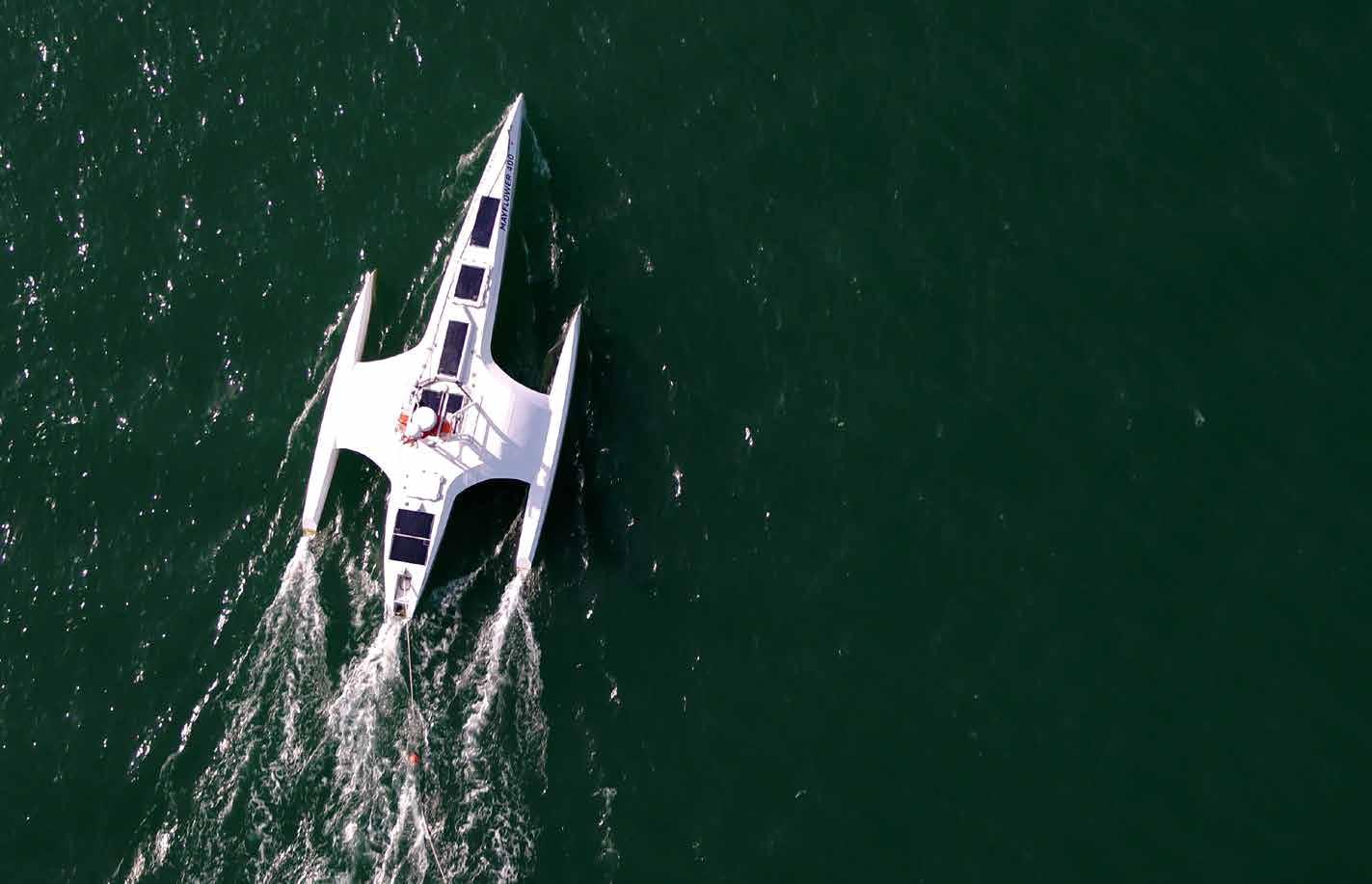
Similarly, in Amsterdam’s iconic canals, electric and fully autonomous Roboats – developed by the Massachusetts Institute of Technology (MIT) – have already been successfully tested, transporting people and products without any human intervention. While it’s a small start, the technology can soon be scaled as is the case in Norway, where the Yara Birkeland – described
as the world’s first fully electric autonomous cargo ship – is busy ferrying freight from Porsgrunn down to the port in Brevik.
Although autonomy on the ocean is advancing at pace, it might still be some time until we see superyachts navigating the Med without a crew and captain – after all, having a full team of primed staff at your service is part of the appeal when it comes to superyacht cruising. As for cars, the idea of settling down to watch a movie or catch up on some work or sleep while the car does the driving might still be a while off, despite brains like Elon Musk giving it all they’ve got. In the meantime, nifty driver assistance programmes are already making driving less taxing and, crucially, safer.
Compared to only a few years ago, the cars and boats of today are infinitely smarter, sharper and connected, dealing with and acting on more data than any human could comprehend. Whether you’re reluctant to hand over control to AI or raring for the next best thing in transport tech, the progress isn’t showing signs of slowing.
Ready or not, here they come.



Strong CEO positioning strategy is a ‘superpower’ that helps lift leaders and their companies above the competition. But how and where to begin?
Words : Lysanne CurrieRecent research shows that a CEO’s reputation now contributes to a half of an organisation’s overall perception— and around 60% of a company’s market value. With this impact, the traditional profile of a distant, lofty figure of power shrouded in mystery and detached from the world is long gone. Today’s leaders are a new kind of ambassador for their companies, and the most savvy are focusing on their own positioning to augment their impact on business perception, culture — and, ultimately, the bottom line.
So, what exactly is CEO positioning and why is it the ‘new superpower’? Simply put, it is a strategic way of defining and leveraging an executive’s personal brand. It acts as a clear
signal to stakeholders and investors – as well as potential new clients – that a CEO is in step with the organisation’s purpose and is someone who ‘walks the talk’. At its heart, it pivots on transparency and authenticity; nearly half of all millennials now expect CEOs to speak out about matters that are important to society, which in turn, influences who they buy from, while 56% of gen Zs – the oldest of whom are now nearing their mid-20s and in the workforce – say they won’t work for a company that isn’t purposeful.
Some of the world’s most notable high-profile CEOs are powerful proponents of careful, strategic positioning, from Warren Buffet and Sir Richard Branson (pictured) to Elon Musk. And in all cases, an artfully crafted media presence means that
these CEOs are perceived widely as much more than just experts in their own narrow fields; they are thought leaders, motivators, communicators and visionaries who are constantly pushing boundaries. At this apex, the power of perception is amplified into one of ‘business rockstars’ — celebrities as much as they are business leaders — but it is one that can have a powerful impact whatever the size of the company or industry.
In many ways, the upswing in mindful CEO positioning is being driven by Gen X, the new cohort of leaders and a forgotten generation, who not only continued the work ’60s boomers began in challenging social norms, but also »

bridged pre- and post-digital worlds — accelerating the dismantling of stereotypes about what leaders and ‘grown-ups’ could and should be. With this confidence, they are leading the way in a new type of CEO authenticity — one that is direct, personal and impactful — and far from the traditional staged messages of PR or internal comms.
Being purpose and value-driven is the zeitgeist for modern business, with organisations increasingly coming under scrutiny around both from customers and stakeholders alike. As Fast Company writes, “Society and stakeholder expectations for CEOs are higher than ever. They are expected to be purpose- and value-driven, visible, and relatable, especially with millennials becoming a large part of the employee and customer audience…”
Now, the figure who represents a company needs to clearly embody and personify it too — and that means using strategic positioning.
Visible alignment with a brand’s values and key messages is crucial — and in 2023, these are most powerfully played out to the widest audience across social media. According to a recent study by the University of Leipzig and the Norwegian Business School, CEO positioning has now become a top corporate priority, owing to a ”rise in the mediatisation of society and organisations”. The study notes that, “CEOs personify and represent their organisations through their visibility in media… in this way their leadership influences perceptions of the organisation among stakeholders – and thereby organisational reputation and performance.”
Part of this strategy is to create a web of credibility and vision, connecting with thought leaders in the same field; for example, via retweets and discussion forums, through writing articles for trade journals, LinkedIn or other media and taking up high-profile speaking engagements.
However, this is just one arm of such a strategy, focused on defining the CEO as a thought

leader. It is social media that is the key vehicle through which CEOs can connect directly with stakeholders and show their human side, displaying empathy, honesty and emotional intelligence, all of which lie at the heart of progressive business practice.
This understanding of social media’s importance in conveying a personal narrative that can affect every part of a company is growing. In 2016, only 32% of Fortune 500 CEOs had a social media presence; by August 2022 that figure was up to 70%, with LinkedIn still the primary platform of choice.
Through a solid social media presence, a leader can contribute compelling content, sharing articles or links that correlate with a personal and public vision — a key part of positioning. Leaders doing this successfully reap the benefits; crafting standout, meaningful and passionate narratives that contribute to their long-term strategy and help to build powerful roadmaps for engagement. However, it is not enough to be seen; for true impact, visibility must align with authenticity. Leaders need to fully believe in their message and strategy and own it in every communication channel for their charismatic presence and clear positioning to shine through.
Strong positioning can help lift leaders and their companies above the competition. Very often, it can pay dividends in areas beyond the bottom line: for individuals, it could boost reputation or rebrand a career, lead to a place on a board or an increased demand for speaking engagements. For the company, it sends the right signals to attract new prospective clients and can be instrumental in drawing in and retaining customers and talent, solidifying brand identity in the marketplace and uniting workforces under consistent and inspirational leadership.
Knowing what you stand for is key in life – and now in business, the CEO with an eye to success knows it has become the true competitive advantage.
Leading the way: Musician Pharrell Williams is Louis Vuitton’s new men’s creative director (main); Vogue's Anna Wintour is considered the most powerful woman in fashion (top right)
SOME OF THE WORLD’S MOST NOTABLE HIGH-PROFILE CEOS ARE POWERFUL PROPONENTS OF CAREFUL, STRATEGIC POSITIONING, FROM WARREN BUFFET AND SIR RICHARD BRANSON TO ELON MUSK
Your executive narrative must be aligned to the company strategy. How can you promote your organisation’s position and be perceived as its prime brand ambassador?

A strong profile means a consistent, relevant story that is easily discovered across multiple online and offline platforms to enable direct engagement with internal and external stakeholders.

Share your views via channels most likely to influence your stakeholders. Establish thought leadership through media exposure, speaking at trade conferences and interviews with business magazines.
BECOME CRISIS-READY
Leaders who wait to respond in crisis create uncertainty. Planned communication creates resilience, enabling you to respond promptly and confidently, with key messages and holding statements.

London. New York. Hong Kong. When we think of the world’s most affluent cities, these are the locations that immediately spring to mind for their historic and luxurious legacies. But there may be some new designer destinations rising to challenge the old guard – as the Julius Bär Global Wealth & Lifestyle Report 2023 shows.
The report, released in June by the Swiss wealth management group and private bank, is the firm’s annual assessment of global trends. Its Lifestyle Index is based on a review of 20 goods and services that represent discretionary purchases by high-net-worth individuals (HNWIs) globally – ranging from property and lawyers to supercars and designer handbags. The cost of these items in 25 key cities are then compiled and compared, to examine trends on global, regional and categorial levels.
So, what are the key findings? It will be unsurprising to learn that, three years on, Covid-19 recovery is still a major factor – but perhaps not in the way one would expect. People are enjoying hospitality – such as holidaying and eating out – at levels not seen since before early 2020, while demand spikes on “lockdown favourites”, such as laptops and bicycles, have eased.
“We are navigating uncharted territory when it comes to understanding the lasting effects of the pandemic and finding a way forward in the ‘new normal’,” writes Christian Gattiker-Ericsson, head of research at Julius Bär. “One of the key, and somewhat surprising, takeaways in this edition [of the report] is that the average cost increase of our proprietary Lifestyle Index is bang in line with previous readings. This means prices of premium goods and services kept
climbing at their ‘normal’ levels of mid- to high-singledigit percentage points.”
This is encouraging news, indeed. Christian explains in the report that, before 2022, the “rule of thumb” was that affluent consumers faced double the average rate of inflation. In 2022, where global inflation reached almost 8%, Julius Bär’s Index would have expected to see inflation rise to more than 15% in US Dollars. In fact, the rate of inflation on all goods and services was just 6% in US Dollar over the past 12 months – though local currencies reached an average of 13%.
However, geo-political events – such as the war in Ukraine, Brexit and the climate crisis – are still impacting the global market through cost of living and energy prices.
“Wealthy individuals are adapting their consumption and lifestyle habits both to make hay while the sun shines and to brace for any future shocks”.
Key findings from the 2023 Index reconfirms Asia as the costliest region to live well for the fourth year in a row but, equally, asserts its authority as a key driver of global luxury and economy. In the global Lifestyle Index, Singapore makes its debut as the highest-ranking city, followed by Shanghai (last year’s leader) and Hong Kong. Taipei, ranking at number eight, is the only other Asian city to feature in the top ten.
In the Americas, New York and Miami both feature in the top ten (thanks, no doubt, to the strengthening of the dollar) – with the Big Apple making a significant climb to fifth place from 11th last year – while São Paulo, Brazil, has made the top rankings for the first
1. Singapore
2. Shanghai
3. Hong Kong
4. London
5. New York
6. Monaco
7. Dubai
8. Taipei
9. São Paulo
10. Miami
time. Santiago de Chile makes its debut on the list, joining in 23rd place, and confirming the Americas as the second most expensive region.
This means that, for the first time, the EMEA region is the most affordable in which to live well. While Monaco has held its sixth place position, London is now the only other European city in the top ten, at fourth place (dropping from second in 2022). Meanwhile, Dubai has jumped from 14th to seventh place in 12 months.
In terms of spending power, Index prices shows that our spending has become less about product and more about wellness: fitness and wellbeing practises, health insurance and education – as well as family and financial resilience – have appeared as top priorities for affluent individuals to help prepare for future disruption. This extends to quality time spent in the hospitality sector, too, with spending on gourmet meals and five-star hotels rising in all regions over the last year.
In terms of the biggest price changes, wine (+17.23%) and whisky (+16.15%), hotel suites (+15.25%) and business class flights (+10.13%), and cars (+19.26%) reflect demand, while residential property has seen the largest reduction, falling by -5.76%.
“Our findings show that the world is on the move again, the thirst for travel, experiences, and luxury goods has risen significantly, and people are consistently spending more,” Christian writes. “They are also conscious that health and wellbeing are essential to future-proofing themselves and their families, as well as shoring up their finances to face any unexpected adversity.” juliusbaer.com
the new trends that are changing the face of affluent livingCapital cities: Singapore tops Julius Bär’s global city rankings for the first time
As Joana Vasconcelos launches Wedding Cake, her most ambitious installation to date, we speak to the conceptual artist about building monuments to the women who came before us

Words: Tessa Crowley


Portuguese artist Joana Vasconcelos is no stranger to big concepts, with her monumental installations dominating the grand halls of Waddesdon Manor, the Palace of Versailles, and the Guggenheim Bilbao, to name but a few. But the inspiration behind her extraordinary sculptures is rather more humble than their grand size might suggest.

Born in 1971, Joana began her career as a jeweller and artist before moving to sculptures created from textiles, ceramics and other household-inspired materials. In fact, it is the domestic space – and the craftsmanship that women of generations past used to express themselves – that informs her work, questioning our consumerism society and collective identity through the juxtaposition of domestic environment and public spaces.
Joana came to international renown at the 2005 Venice Biennale with her installation The Bride. In 2012, she was the youngest artist and first woman to have a solo exhibition at the Palace of Versailles, to a record-breaking 1.5million visitors. Her 2018 retrospective dominated the Guggenheim Bilbao. More recently, Joana’s 2023 Tree of Life – a 13m-tall handmade fabric depiction of Daphne’s final transformation – at Paris’s beautiful Sainte-Chapelle de Vincennes, made headlines for its delicate engineering and intricate detail, after her collaboration with fashion house Dior saw the creation of Valkyrie Miss Dior hit the Paris runway in March 2023.
Her latest project, Wedding Cake, is a 12m-tall ceramic sculptural pavilion that will dominate the grounds of Lord Jacob Rothschild’s Waddesdon Manor in Buckinghamshire from 15 June. Guests to the châteauesque manor can take a 45-minute sensory tour of Wedding Cake, before emerging in pairs at the very top.
“I want people to have three different approaches to it,” says Joana. “Looking from the outside, enjoying the surroundings from the different levels or balconies and rising to the top, finally completing the artwork with their presence. Above all, I always thought of it as a temple to love.”
Here, Joana tells us more about her dramatic artworks, down-to-earth inspiration, and how she is building monuments to the home. »


Joana, how has your artistic style developed and evolved?
I studied jewellery and drawing. I learnt how to represent the world through my hands. I don’t think about [my work] as a style but, rather, I think about each new project individually. For me, the most important inspiration has always been the domestic environment. Every part of your house – kitchen, bathroom, bedroom – has a different identity, different objects and textiles, and I’ve been working from that concept for years.
I love opening the drawers of the past; in the past, all the labour that was done by our mothers, grandmothers, aunties. The crafts and objects that were made at home to decorate and protect your environment. We’re very blessed to be able to study, work, have our own personal expression, but that wasn’t true for our great-grandmothers. These women had to express themselves through these techniques and traditions, and I pay homage to them by representing them on this monumental scale.
Could you tell us more about your 2023 installation, Tree of Life?
Some projects are born in strange situations. I was invited to do a show in Villa Borghese exploring Gian Lorenzo Bernini’s sculpture Apollo and Daphne, where Daphne is being transformed into a laurel tree. My idea was to make her final transformation into the tree. I started the project – the engineering, embroidering leaves – but then it stalled due to Covid-19. During lockdown, our team was bored at home, so we continued [to create the tree].
Later, I was invited to Paris and we decided to develop the tree for Sainte-Chapelle – but I had to redesign it. Instead of being 5m tall, it became 13m; instead of a few leaves, we had 140,000. It was a much bigger [project], but still completely handmade, and valuing these traditional domestic crafts.

It’s based on the myth of Daphne and the essence of transformation – how important is mythology to your work?
I think all projects have three dimensions; physical, conceptual, and spiritual. Physical is the technical – it’s engineering, materials, technique – everything that connects you to earth. The conceptual dimension is the idea. This one comes from Daphne: she renounces her fate, so there’s an aspect of self-determination, of believing in yourself. Then the spiritual aspect – for Tree of Life, that came from the SainteChappelle itself, where you have the apocalypse depicted on the windows, the end of the world, taking you to a spiritual dimension.
Now you’re unveiling Wedding Cake, one of your most ambitious and interactive works to date. What can we expect?
It’s a gigantic ceramic piece. It’s a building; a temple. People can access the top floor [of the cake] in pairs, whether that’s two women, two men, people that don’t know each other, people that do. They might be people that are going to marry, are remarrying, renewing their vows. It’s a new aspect of tradition.
Marriage is one of the most important moments of most women’s lives. It’s when we transition from one family to another. There’s this sense of independence associated with marriage, and a lot of people still use the traditional symbols of this transition: the wedding ring represents the moment you promise to be married; the wedding dress represents the moment you are married; and then the wedding cake appears at the end of the party – now you go to start your new life.
You are also known for collaborating with the likes of Dior – how do fashion and art intersect for you?
I’ve been working with fashion designers for a while. Once, [fashion designer] Valentino came to the studio. He said, ‘Oh, you’re like an haute couture studio’. And it’s true; we work the same way. Every fashion designer that’s come here, from [Dior’s] Maria Grazia Chiuri to Karl Lagerfeld, has made the same comment. It’s easy for me to collaborate with them. I work with a lot of techniques close to the fashion world – in fact, I’m closer to fashion than I am to traditional sculpture.
Finally, tell us about your recordbreaking exhibition at Versailles. What captured people’s imaginations?
Versailles is the paradigm of European culture, in the sense of those big châteaux and great houses of history. We have them in England, France, Belgium, Germany. We understand the traditional way of the grand house, of the table, of the domestic environment. So, unlike other artists might, I didn’t impose my work on Versailles, I produced my work for it. There was a relationship [between art and environment] that people understood as they arrived and explored. They felt the connection, the empathy. The textiles interconnected with each space. They felt at home – and that was what made it a success.
joanavasconcelos.com; waddesdon.org.uk
I THINK ALL PROJECTS HAVE THREE DIMENSIONS; THE PHYSICAL, THE CONCEPTUAL AND THE SPIRITUAL
When it comes to home décor, the right home fragrances can define a room, set the mood and leave a lasting impression. Tempus brings you the scent-sational fragrances transforming your living space

Scent plays a vital role in how we experience our surroundings, even if we’re not always conscious of it. One only has to walk into a spa, air filled with lavender and bergamot, or a bakery, warm with the smell of freshly baked bread and well brewed coffee, to realise just how much our nose informs our mood. While spas, hotels and boutiques may expertly employ fragrance as a “scent training” method to soothe, energise or entice guests, there are also myriad benefits to applying the same techniques to our own homes.
The right home fragrance can enhance the sensory experience of any space, creating the perfect ambiance that aligns with how the area is being used. For example, a diffuser gently releasing the scent of vanilla and spices is ideal for a foyer or entryway, as these fragrances are energising and inviting. Kitchens and bathrooms benefit from citrus notes and green herbals, which signify freshness and cleanliness, while a pine or sandalwood-based candle in your living room or den will create a cosy, warm
atmosphere in the evening. For the bedroom, lavender is a classic relaxing scent, and experts recommend blending lavender with notes of rose to encourage sweet dreams or frankincense to spice things up.
“Fragrance, like design and style, is gloriously subjective and ever changing,” says Jane Comyn, co-founder of home fragrance brand Branche d’Olive. “When contemplating new fragrances for your home, I suggest three broad guidelines. Firstly, what is your general olfactory preference? Is it citrus, floral, oriental, woody? Secondly, does whoever you share your living space with have the same preferences? And, finally, would you consider different fragrances for different spaces?”
And don’t think that your home scent solution can’t look just as sophisticated as the rest of your interior style. Whether you opt for high-tech oil diffusers, sculptural incense burners, aromatic candles or classic reeds housed in crystal, we’ve sniffed out the hero fragrances designed to be a perfect part of your décor. »


Celebrated perfumer Compoz Parfum’s Le Compositeur is a satisfyingly high-tech diffuser that lets you change the mood of your home at the tap of an app. The heart of the beautifully designed piece is a natural, bespoke essential oil diffuser, which features a touch screen and connects to a mobile app that allows users to create olfactory playlists, scheduling a variety of bespoke or ready-made scents to be diffused depending on your mood or plans. Retailing from £990, this smart diffuser fuses great design with true scent revolution, setting the scene for a party mood or a relaxing night in alike. »
compoz-parfum.com

Exquisitely crafted from porcelain and 24k gold, this creates an interior statement that fuses practicality with stylish design. Priced at £1,510, this finely crafted objet d’art showcases L’Objet’s playful approach to design and makes for a perfect conversation piece, even more so when the incense is burning – place your desired scent into the monster’s torso and watch as smoke is released through its brass horns for whimsical sculptural perfection.
luxdeco.com
One of the UK’s most exciting perfumers since 1730, Floris is best known for its bespoke fragrance services – which are not to be missed for those seeking the perfect fragrance or a thoughtful gift. But the brand’s home fragrance collection – dating back to the 1800s – is equally indulgent. Floris’s range of reed diffusers, room fragrances and scented candles are all beautifully presented and come in a range of scents that celebrates British horticulture – from Grapefruit & Rosemary, Cinnamon & Tangerine, Hyacinth & Bluebell – as well as classic scents like Sandalwood & Patchouli and the bestselling Oud & Cashmere.
florislondon.com

Founded in Hamburg by artist and candle chandler Karimah Ashadu (below), Pieces of the Cloud (POTC) is a niche brand inspired by the “elegance of fine living”. With signature scents including Burnt Basil, Earl Grey & Iris, Roses & Tomatoes, and Grapefruit & Lavender, these candles are ethically created to the strictest standards – from ethically sourced rapeseed and sustainably farmed coconut to natural cotton wicks and packaging made from recycled materials. The candles promise powerful, longlasting fragrances perfect for scent training a space, thanks to the intense aroma that lasts over time. Most exciting is the bespoke service, which allows customers to create their own custom candle fragrance for a truly unique aromatic experience.
piecesofthecloud.com

Founded in 1961 at 34 Boulevard SaintGermain in its eponymous home city’s fifth arrondissement, Diptique Paris is synonymous with luxury travel thanks to its sought-after partnerships with hotels including the RitzCarlton collection. The brand’s eau de parfum, eau de toilette, scented candles and perfume oil diffusers come in a range of indulgent fragrances, each with a story, while options such as hourglass diffusers are true objets d’art. Diptique’s new summer collection combines Parisienne style with practical fragrance design – the Citronelle 190G candle (right) is the ideal way to bring home fragrance into outside spaces, filling your terrace, balcony or garden table with tangy notes of lemongrass while keeping mosquitos away.
diptyqueparis.com

Newly relaunched with a sustainable manifesto, Branche d’Olive is favoured by the likes of legendary chef Raymond Blanc, who has enveloped each of his personally designed rooms of his Le Manoir aux Quat’Saisons culinary hotel with one of the brand’s decadent blends of fragrances. The signature scent, Garrique, is a heavenly cologne with top notes of bergamot and citrus, aromatic lavender and thyme on a woody sandalwood base, and is available as a generous reed diffuser, soya candle (left) or room spray – as well as soaps, shower gels and lotions. Co-founder Jane Comyn says: “Our credo is quality without compromise; sustainable style with complication.”
branche-dolive.com


The mindshift around health is seismic, with longevity and wellness – in body and mind – prized highest of all. With joined-up thinking and fast-paced innovation, living longer is now more attainable than ever
Words: Lysanne CurrieAmong the most desired commodities in this world – whether gold, petroleum or a personalised performance from Taylor Swift – there exists an intangible yet universally desired prize. It cannot be grasped in one’s hand, yet it is the most sought-after possession of all time. For a new breed of ultra high net worth (UHNW) individuals, especially in the aftermath of the Covid-19 pandemic, the pursuit of accumulating more – and, crucially – healthier biological miles has taken on a heightened urgency, fuelled by the recognition of our fragility and the preciousness of every passing moment.

In our modern era, however, the journey of ageing no longer carries the grim inevitability of a steady decline into frailty, daily tablets and decay. And that’s particularly true for the affluent elites who can afford the finest health care in the world.
And wellness is big business. In 2023, the global market is valued at over $5.3trn (£4.29trn); in the UK alone, it’s estimated to hit £30.6bn this year. If the health and wellness industry growth rate stands at 10%, it’s expected to continue at this pace until 2025. Trends abound: from biohacking to delay aging and prevent disease, wellness tourism – whose market is projected to reach $915bn (£741bn) this year – and digital wellness (tech we can use at home, including apps).

At the beginning of 2023, leading hospitality group Accor released a white paper titled The Road Map Towards a Transformational Well-Being Culture, providing research and insights into eight key pathways for navigating business, society and leadership. As Emlyn Brown, the brand’s global vice president of wellbeing, said: “It demonstrates that wellbeing must be recognised as an imperative for all if we are to maintain the equilibrium of our lives, our society, and our planet.”
The paper’s key findings and recommendations include that wellbeing must bring together body and mind (noting the well-documented link between mental and physical wellbeing); that access to healthcare needs to be fully democratic; and that technology must become a force for good. There are ramifications for business here too. If UHNW clients have access to better healthcare, there’s a good chance they may implement more holistic strategies into the workplace, to ensure a healthier workforce. Economically, it makes sense to shape, inform and create a culture of wellbeing.
And wearable tech is indeed playing an increasing role in workplace wellbeing, with the market currently valued at around $37bn (£30bn). Smartwatches, smart patches, and smart helmets are all being used to monitor employees’ health indicators and collect data on sleep habits and activity levels. »
For Accor, such “joined-up thinking” is another must “for true transformation”. And joinedup thinking is exactly what a recently opened longevity clinic, in London’s Mayfair, promises to deliver, via a sort of ‘cubist’ approach to health for time-poor UHNWIs.

Founded by Lev Mikheev – a Russianeducated polymath whose career has encompassed everything from theoretical physics, finance, and 21st-century medicine –bespoke healthcare service Hooke offers clients “a first of its kind” service in the form of a health management system. According to its CEO –Mikheev’s daughter, Kate Woolhouse – Hooke was originally set up as a “conceptual idea of what a longevity clinic would look like”.
What if there were a way to live a longer, happier and healthier life? asks Hooke’s literature. “A place to personally access the latest in biology, medicine, psychology, and
data science, where the experts in these fields work collaboratively to create a new paradigm for living well?”
Rather than pinballing between different health providers – such as nutritionists and therapists – in a time-consuming whirl, Hooke offers its time-poor but healthfocused members wraparound support and personalised longevity programmes, devised by a team of elite doctors and specialists.
“If you’re in your 30s, with small children and a busy job, outsourcing your healthcare to a single place is something people find very convenient,” explains Kate.
Hooke’s methodology includes screening and early diagnosis of diseases, “to make sure we catch anything at the stage where we can still do something about it”. Plus a “brain health assessment – a look at emotional resilience, and personality typing, to see where the roadblocks might be.”
Living longer: Hooke offers its HNW clients a full a health management system, with physical and mental wellness at its core (pictured)
Ultimately, says Kate, fitness and exercise are the greatest cure: “Keeping yourself physically active has been shown to have the best ability to prevent cognitive degeneration. You just have to keep going.
“We do try and make it easy for people… we give you an active, targeted programme that fits in with your lifestyle, enabling people to make changes,” she explains. “We’re setting people on a trajectory which means they can stay healthy well into their 80s. They can still spend time with their families, enjoy their hobbies and carry on with their work if that’s what they want to do. And it’s all done, mostly, through quite simple but well-tuned lifestyle changes.”
Hooke has already attracted a diverse client base. “We always thought our demographic was going to be 50-plus UHNW individuals who’d made their money, and this was now their time to focus on their health. But, actually, we’ve been surprised by how many younger people have joined us.”
No surprise to the statisticians: in 2019, the average millennial spent £155 a month on health and fitness, a figure, as Women’s Health says, “that easily makes us the most healthconscious generation in the UK”. Equally, it’s this demographic which is driving the change for mental health to be taken more seriously in the workplace.
As Kate acknowledges, there’s currently a “huge conversation” around mental health. “For a lot of people, it’s about managing stress. Maybe they’re having sleep problems and that’s affecting their ability to work on their health as much as they’d like.”
Again, there’s a recognition that body and mind are one. As Accor’s white paper states, “everything is connected when it comes to health and wellbeing. It’s your responsibility to make the choices and take the right steps in preventing illness, maintaining fitness, eating healthily, developing resilience and cultivating contentment that will nourish your wellbeing.”
Sentiments that the elite team of specialists at Hooke, working towards the healthy and happy expansion of life, would surely encourage.
group.accor.com; hooke.london


As we mark 50 years since the London Stock Exchange welcomed its first female members, Tempus asks Winterflood’s Stacey Parsons and original LSE member Sarah Danes about their time on the trading floor
Fifty years ago, Susan Shaw became the first woman to walk on the trading floor of the London Stock Exchange (LSE) as a full member. A former LSE tour guide in the 1960s, Susan worked in the back office for financial firm Williams Mortimer before they finally sponsored her membership. On 26 March 1973, Susan made history.
Hilary Pearson, who first joined Sheppards and Chase in 1969, also became a member that year – in 1976, she would be offered a partnership in the firm, making her the only female partner in Sheppards and Chase’s history. Susan and Hilary were among a handful of pioneering women who battled prejudice and expectation to go toe-to-toe with their male counterparts on the trading floor, opening the doors for the 400,000 women who make their name in the finance sector today, and contribute £64bn to the UK’s GDP every year.
“Change has come, but so much more is required,” Julia Hoggett, the LSE’s CEO, told the Financial Times in March. Julia is both the first female and first openly gay person to hold the top role at the LSE, having joined in 2021 from the Financial Conduct Authority after 25 years on the trading floors.
Julia told press: “We owe those trailblazers a huge debt: they imagined a world where women could become members of the Stock Exchange and then stuck it out to both make it happen and, just as importantly, make it stick.”
Stacey Parsons, head of fixed income strategy at leading UK market maker Winterflood Securities, agrees: “Today,

we stand on the shoulders of the giants who opened the pathways to women entering finance 50 years ago. The number of women represented at CEO, COO and CFO positions, and broader improvements in representation at board level – now moving towards 40% – must be commended. Equally as important, the ‘C-suite’ level is full of women leaders who are delivering, shaping and supporting change for the next 50 years and more.
“We are truly starting to see the next generation of women securing seats at the table, and I believe this will only become stronger, better, and fairer as we move forward, with so many bright, diverse minds in the room now.”
Stacey joined Winterflood as a trainee in 1997, and soon decided to follow in Susan and Hilary’s footsteps by becoming a trainee investment trader – known as a ‘blue button’.
“It was my CEO at the time who supported the move and, 26 years later, I am proud that I had the courage and resilience to ask for a change from my allotted administerial settlement job,” says Stacey. “The advice I always give to my networking groups is to have open and honest conversations, as you never know where it might take you. It is important to champion equality in all walks of life; I believe that open and honest dialogue delivers productive outcomes for business, society, our peers, and the next generation.”
This advice perhaps underscores the work still to be done and, as magistrate Sarah Danes suggests, there is still a balance
to be struck. Sarah, who previously worked at Winterflood in business development, first joined the LSE in 1978 with Vivian Gray stockbroker. Now retired from the City, Sarah still plays an active role in the legacy of financial services as a committee member of the Stock Exchange Benevolent Fund.
“In my experience, there have never been many women attracted to join financial services as a career. The working hours are long and fixed. Dealing rooms can be male-dominated,” explains Sarah. “It is a shame that more women have not been enticed into the world as it is a rewarding career. I always found my roles stimulating and enjoyable, being involved with bright and intelligent individuals always at the forefront of technology.”
However, as women do become more widely represented in the financial sector, Sarah says it’s time to look beyond gender to ensure that the industry is supporting diverse talent from all underrepresented backgrounds.
“Equality and diversity are important in any industry,” she explains. “The importance of equality of minorities is paramount. I feel it is not just women that should be encouraged to look at this industry for a career but all types of minorities, as this would bring a muchneeded influx of new talent to the industry.”
With such trailblazers at the helm, there is no telling where the next 50 years will take the City.
londonstockexchange.com; winterflood.com


serve suggestions

• Manzi’s brings sensational seafood to Soho
• Home House’s colourful Pride Month celebrations
• V&A South Kensington marks 75 years since the Windrush
• Save the date: your luxury events calendar
Actor Ryan Reynolds shares his summer cocktail
AVIATION OVATION
40ml Aviation American Gin | 90ml Soda Water | Orange Slice
Actor and entrepreneur Ryan Reynolds is celebrating the British summertime with a new selection of summer serve suggestions for his premium spirit, Aviation American Gin. Aviation has been voted the world’s highest-rated gin by Wine Enthusiast, which scored it 97 points, and has helped establish a new style of American gin – softer and smoother, with juniper in the background and citrus and floral notes in the front –resulting in more balanced cocktails.
Ryan became co-owner of the Portland, Oregon-based gin in 2018, which was acquired by premium spirits group Diageo in 2020. At the time, the Free Guy actor said: “I became an owner of Aviation Gin because I love the taste of Aviation more than any other spirit. What I didn’t expect was the sheer creative joy learning a new industry would bring.”
Now, to celebrate World Gin Day in June, Ryan offers up these star-quality cocktail serves.
aviationgin.com
Pour Aviation American Gin into a highball glass filled with ice. Top with soda water and garnish with a slice of orange.
AVIATION HIPSTER HARVEY
40ml Aviation American Gin | 60ml Orange Juice | 15ml Vanilla Liqueur | Orange Slice
Combine all ingredients into a flute glass and top with vanilla liqueur. Garish with an orange slice.
THE AVIATION
45ml Aviation American Gin | 15ml Maraschino Liqueur | 15ml Lemon Juice | 10ml Simple Syrup | 1tsp Crème De Violette | Brandied Cherry
Combine all ingredients in a cocktail shaker with ice. Shake, then strain into a coupe glass. Garnish with a brandied cherry.
40ml Aviation American Gin | 90ml Soda Water | Lime Wheel
Pour Aviation American Gin into a highball glass filled with ice. Top with soda water and garnish with a lime wheel.


Soho welcomes a new iteration of famous fish and seafood restaurant Manzi’s as the muchloved restaurant opens at Bateman’s Buildings – connecting Bateman Street and Soho Square – on 29 June. Paying homage to its famous forefather, which served Londoners from Leicester Square for more than 50 years, Manzi’s menu includes classic dishes such as moules marinière, crustacea and catch of the day, and Dover sole.
More contemporary selections include calamari in tomato sauce, fried violet artichokes with sauce gribiche and a New York shrimp burger served with spiced mayonnaise, while speciality dishes include a mouthwatering monkfish Wellington served with a prawn mousse and dill beurre blanc. Pairing suggestions come in the form of a playful cocktail list featuring Old Cuban, White Negroni, and Mediterranean Mary.
The new launch from the Wolseley Hospitality Group also boasts interior décor conceptualised by Fabled Studio, who have updated the hedonistic vibe the original Manzi’s was so well known for. Expect mermaids and sea creatures in abundance against a palette of soft blues, whites and sea greens across the restaurant’s two floors.
Manzi’s, Bateman’s Buildings, London W1D 3EN. Opens 29 June 2023
manzis.co.uk
EXHIBITION
On 22 June 1948, the Empire Windrush arrived at the port of Tilbury, near London, with a group of 1,027 passengers and two stowaways, all migrating from the West Indies. The ship became an enduring symbol of the generation of Commonwealth citizens who migrated to postwar Britain between 1947 and 1971. Now, 75 years since the Windrush arrived in the UK, the V&A is marking the occasion with a series of exhibitions and events throughout the year. Highlights include the exhibition Between Two Worlds: Vanley Burke and Francis Williams (opens 12 June), which explores portraits of “two Jamaican gentlemen scholars” created three centuries apart, and a Lunchtime Lecture of the same name on 22 June. Other speakers in the series include Arthur Torrington CBE, who will host Keeper of the Windrush Flame on 10 June, and artist Dr Michael McMillan discussing his installations in The Front Room Portraits: Diaspora Migrant Aesthetics in the Home on 10 August.
V&A South Kensington, Cromwell Road, London SW7 2RL. Ends 31 December vam.ac.uk


Private members’ club Home House is celebrating Pride month with a series of events and installations that honour diversity, love and inclusivity. Special members events include a talk by historian Mok O’Keeffe titled LGBTQ+ Icons You Didn’t Know About, But Should…, while a series of limited edition cocktails – including the Aphrodite, a blend of Belvedere vodka, Mastiha spirit, agave, lemon and raspberries – will also be available. At the apex of the celebrations is the Pride Party at Home House on 30 June – the first of a new annual tradition for the club. The inaugural event will feature music from special guest DJ Fat Tony and hosted by drag artist Grace Shush, and proceeds from sales of the Aphrodite cocktail will be donated to the Pride in London charity. Resident florist Ricky Paul Flowers has also created a vibrant installation in rainbow colours. Andrew Richardson, managing director of Home House Collection, says: “Pride is a momentous occasion that allows us to come together, celebrate love and equality, and most importantly, all the multifaceted members that make our club so special.”
Home House, 20 Portman Square, London W1H 6LW. 1-30 June homehouse.co.uk
HENLEY ROYAL REGATTA
Our favourite local regatta returns to Henley-on-Thames, with world-class rowing events at the centre of the most elegant festival in the calendar. Head to the Regatta Enclosure on Henley Beach to enjoy royal hospitality at the heart of the action. hrr.co.uk

PARIS HAUTE COUTURE WEEK

This year’s Paris Haute Couture Week is home to the best couturiers in the world. As July turns its eye to autumn/winter style, Paris will celebrate all things Chanel, Dior and Schiaparelli with artistic feats on and off the runway. fhcm.paris
7 - 9 July 19 - 26 Aug
F1 BRITISH GRAND PRIX
Start your engines as Silverstone prepares for an action-packed GP. Red Bull’s Max Verstappen and Sergio Pérez remain favourites, while exciting performances are expected from the likes of George Russell and Charles LeClerc. f1.com

HAMILTON ISLAND RACE WEEK

Prepare for a yachting experience like no other, as owners and enthusiasts set sail to Hamilton Island for Australia’s largest offshore keelboat regatta in the picturesque Whitsunday Islands on the edge of the Great Barrier Reef. hamiltonislandraceweek.com.au
While every effort has been made to ensure accuracy, changes to event calendars may occur. Please check with individual event organisers for more information.

Summer sport begins in style with Novak Djokovic set to defend his Wimbledon title. Enjoy the thrills and spills of the tournament from your seat in Centre Court or while picnicking in style on Murray Mound. wimbledon.com
30 Aug - 9 Sep
VENICE FILM FESTIVAL
With cinematic events hosted across Venice and celebrity guests galore, the 80th Venice Film Festival will be its most glamorous yet. Hong Kong actor Tony Leung Chiu-Wai (In the Mood for Love) will receive a lifetime achievement award. labiennale.org







































 Erling Haaland Pro footballer, member of the all-star squad
Erling Haaland Pro footballer, member of the all-star squad





I’m not sure about you but, in my household, there’s always a collective sigh of relief when the temperature finally hits the twenties. The warmth of the air, the sun kissing your skin, the breeze gently swaying. Suddenly there’s a little spring in your step, and there are more smiles on people’s faces as we welcome a much-needed injection of vitamin D.
The issue with London, though, is that stint of mild weather may last but a few days. Or the temperature doubles to the point where the oncewelcomed summer sun is more akin to a furnace. Therefore, with this summer season in full swing, it’s time for the great escape to more tropical conditions for a well-deserved holiday – which invites the question: what do I pack?
Well, I don’t need to relay the essentials, as I’m sure you’ll know it’s important to bring SPF, sandals
and swimwear. However, there are a few pieces I’m making sure I take with me on my next sojourn to ensure I stay looking and feeling cool.
I’ve recently come across the Jimmy Fairly brand, after a friend introduced me to them when I discussed a need for new glasses. When visiting, I saw so many incredibly cool sunglasses that I immediately put on my wish list. One such pair was the Coolio 2, a rework on a timeless classic, with a geometrical finish that makes them subtle and yet intriguing. Style aside, my favourite thing about the brand is that for every pair made, another is donated to those in need. To date, they have donated more than 600,000 pairs to charity.

When it comes to trousers, Albert Clothing is definitely out there, but trust me on this. Pair these beautiful 1940s-inspired green trousers – each pair a

work of art – with an off-white or beige knitted tank top or polo shirt, and a pair of brown loafers, and you’re good to go. There’s a sense of unadulterated rakishness about them and I adore the detailing, particularly on the waistband and trouser cuffs. Just make sure that the leather of the belt matches the leather of the shoes for a pulled-together look.
Jake Wigham is a brilliant shirtmaker. One of my favourites of his – and a quintessential summer staple – is this blue striped cotton-linen blend popover shirt. Breathable and airy, the relaxed fit of the shirt, with its soft three-button collar roll, shaped hem and patch pocket, makes it a versatile piece throughout the summer, both at home and abroad. Wear it tucked into classic trousers, or open with linen shorts. All shirts are made by Jake in his East London workshop and are made-to-order.


